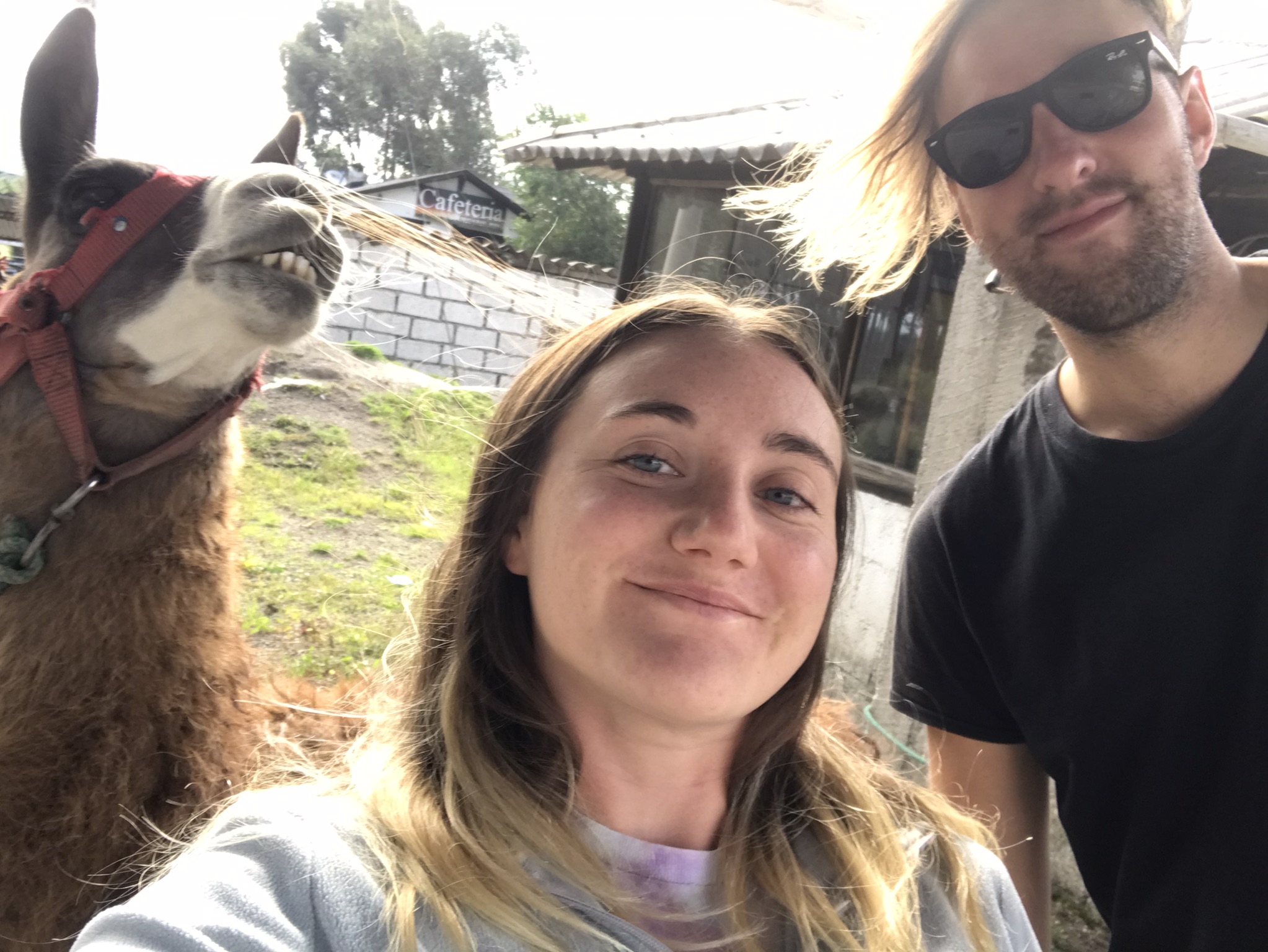With its laid back Caribbean culture, diverse population, variety of island and jungle landscapes, large number of Mayan ruins and tropical weather, Belize is a country with a lot to offer both backpackers and short-term holidaymakers. Check out my Belize travel tips and experiences below!
Belize City, Caye Caulker, Belmopan, San Ignacio

Belize is the smallest country by population in the Americas. The country is hot, humid and very green, mostly covered by dense tropical rainforest and with a low population density. Belize City is the only real city in the country, while the capital Belmopan also has city status but only has a small population and is actually one of the smallest capital cities in the world. Belize has been somewhat notorious internationally as having one of the highest murder rates in the world, but this is a little misleading as historically most of the problems have been related to gang activity in the south side of Belize City, and the statistics are skewed due to the low population. Outside of Belize City we found the country to be very safe. Strangely though, the country is pretty expensive compared to others in the region. Belize dollars are pegged at 2:1 with US dollars, so the currency is stable, and costs for most things are relatively high. Most visitors don’t usually spend a long time in Belize for that reason.
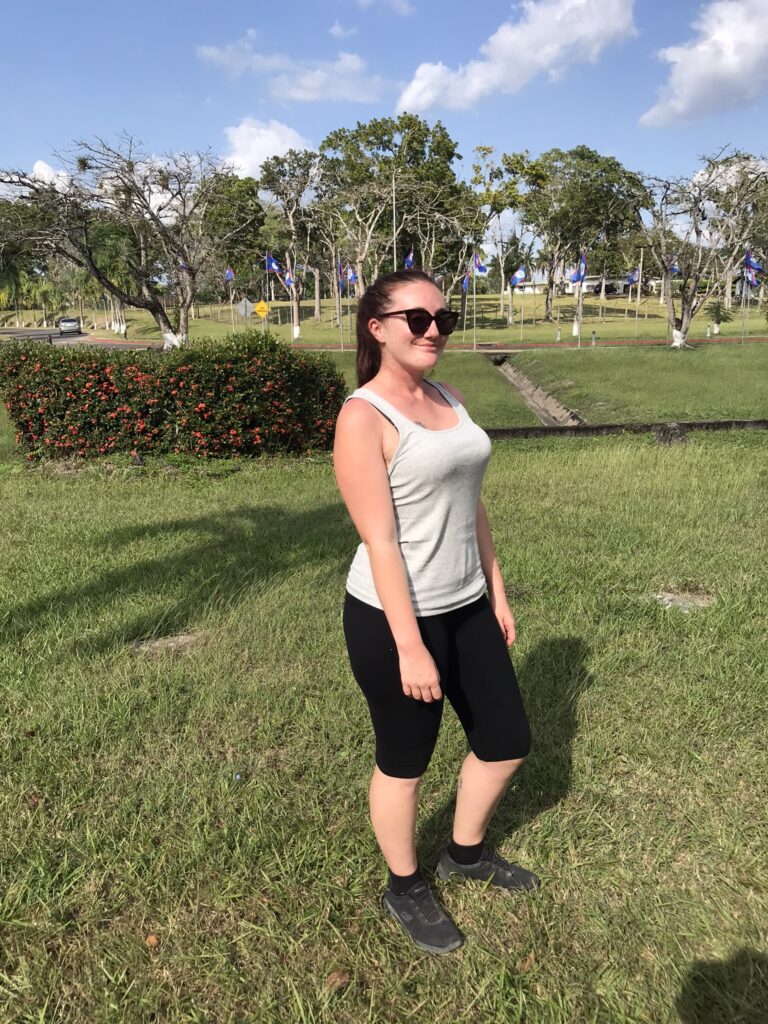
Belmopan, the capital city of Belize, is one of the smallest national capitals in the world
Belize is one of the most diverse countries in the Americas. Historically the indigenous Mayan people inhabited most of the territory, while Belize City was founded as a British outpost/colony which was mainly populated by wealthy merchants and African slaves. Today black Caribbean and English-speaking Hispanic/Maya make up the majority of the population but Belize is an extremely diverse society. We saw plenty of Chinese-owned shops and supermarkets, Garifuna people from Hopkins, Indian people working in the bus station, white pale Germanic-looking Mennonites in full Mennonite dress queuing for Dario’s Meat Pies in Belize City, American ex-pats and a variety of other people. No matter their ethnicity, we found that the people in Belize tended to share the same laid-back, easy-going Caribbean attitude. Food-wise, Caribbean and Latin cuisine also dominates, with rice and beans being the archetypical Belizean dish.
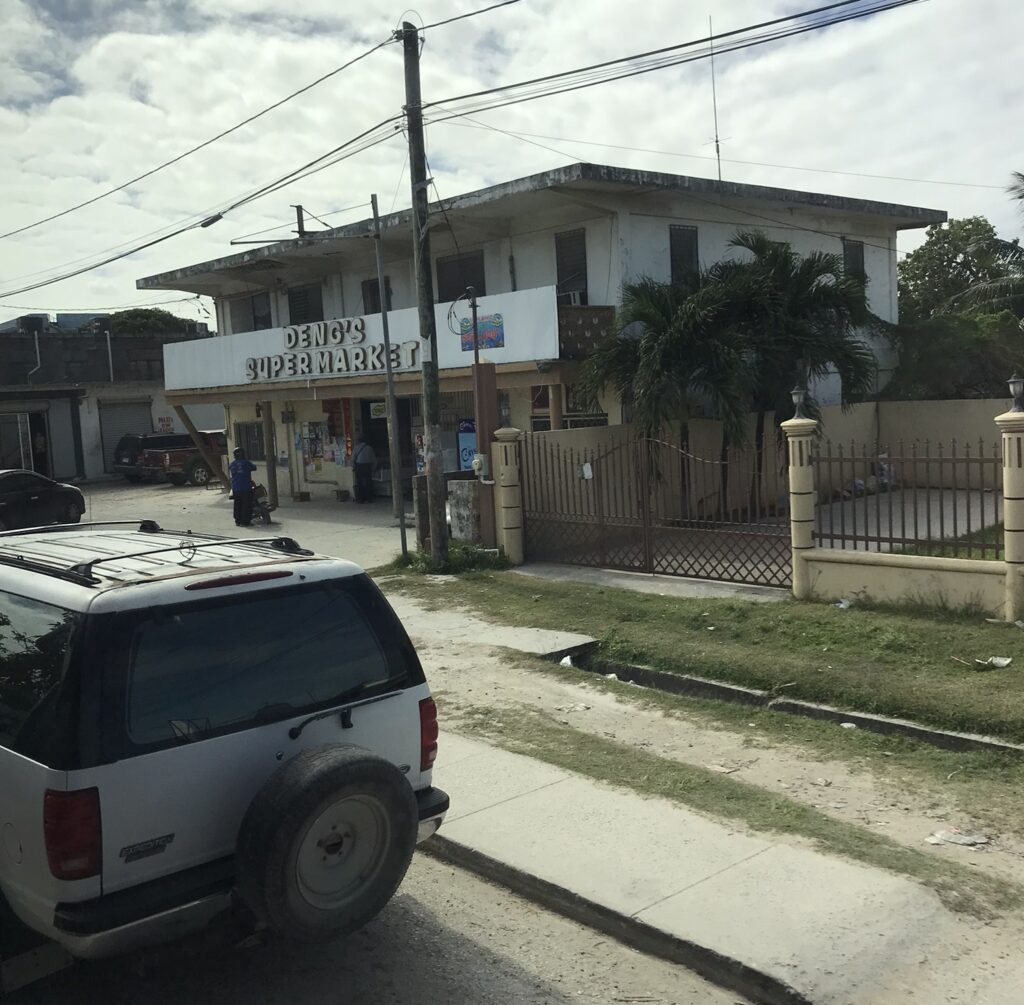
Deng’s Supermarket in the small town of Corozal
Although there are English-speaking outposts along the Caribbean coastline throughout Central America such as the Bay Islands in Honduras, Bluefields in Nicaragua and Bocas del Toro in Panama, Belize is the only country in Central America where English is the official and majority spoken language. We were happy to be able to speak to locals in English and encountered many friendly and interesting people who were happy to chat and to help out. Locals speak to each other in their own creole language which is similar in many ways to Jamaican Patois and other Caribbean creoles, but they will generally switch to standard English when talking to visitors.
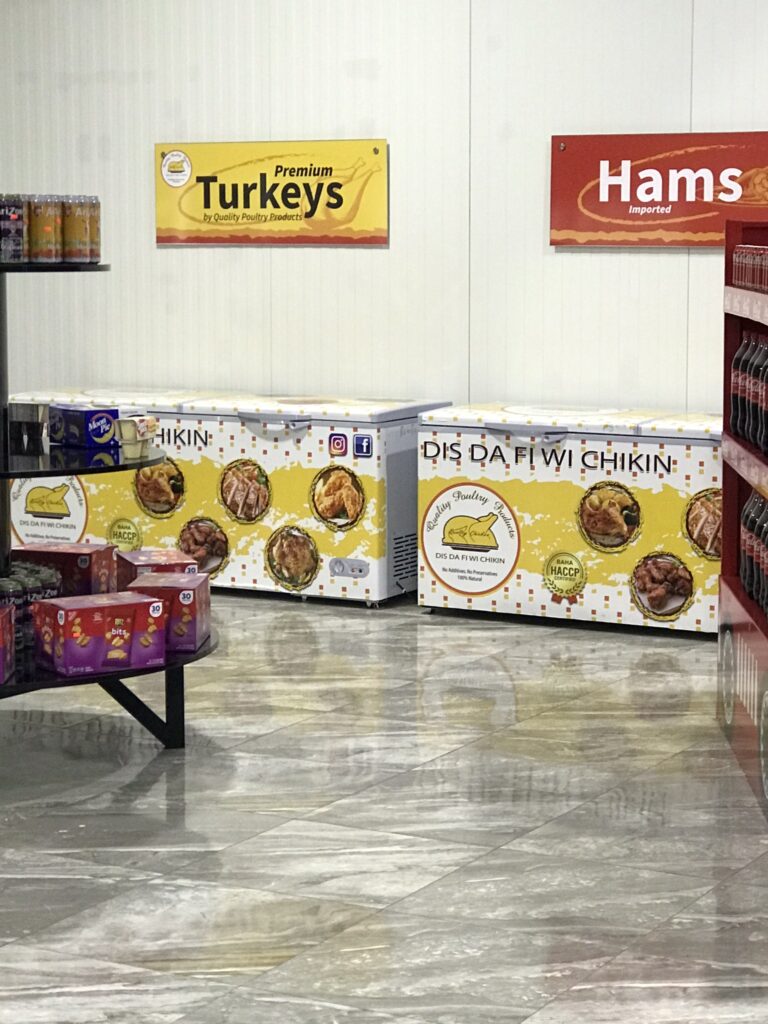
Belizean Creole is most widely spoken among the locals
Belize is one of the easiest countries in the region to travel around by public transport. Because of the lack of major settlements, there are only a few main highways which all pass through either Belize City or Belmopan. This makes bus travel in the country very easy. From Belize City, you can either take a bus going north towards the Mexican border, a bus going west towards the Guatemalan border or a bus going south towards Punta Gorda. Virtually every major settlement will be covered by one of these three bus routes, and with chicken buses running along all of the routes every half hour or so it’s almost impossible to get it wrong. The only exception is the town of Hopkins, which is not covered by the main bus routes and needs a bit more work to visit by public transport. You can check out this website for the latest bus schedules, but generally the chicken buses run every half hour/40 minutes or so from morning until evening.
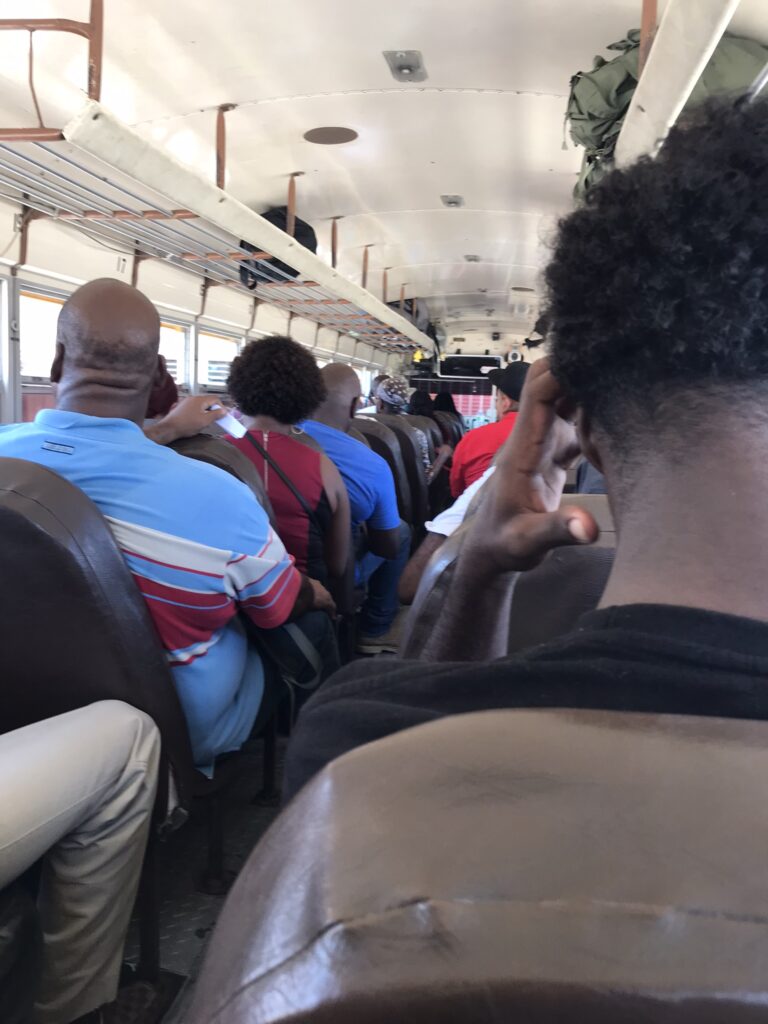
The chicken bus is a cheap and easy way to get around in Belize
Traveling by chicken bus is a great budget option in an otherwise relatively expensive country. We enjoyed listening to the reggae music that was often blaring on the bus, cramming with locals into the small seats and laughing about the questionable luggage storage (usually in Belizean chicken buses luggage is just piled up on the back two seats of the bus, we saw plenty of occasions where it fell onto the heads of the people sitting in front). For my guide to chicken buses in Belize and elsewhere, click here!
We got the bus from Bacalar in Mexico all the way to Belize City, it’s possible to stop off at Orange Walk or elsewhere along the route however most people go straight to Belize City as that is the gateway to Caye Caulker and Ambergris Caye (San Pedro), the main two tourist destinations in the country. Outside of the islands, there are fancy hotel resorts and national parks along the coast further south, while San Ignacio in the west is a popular gateway to numerous Mayan ruins.
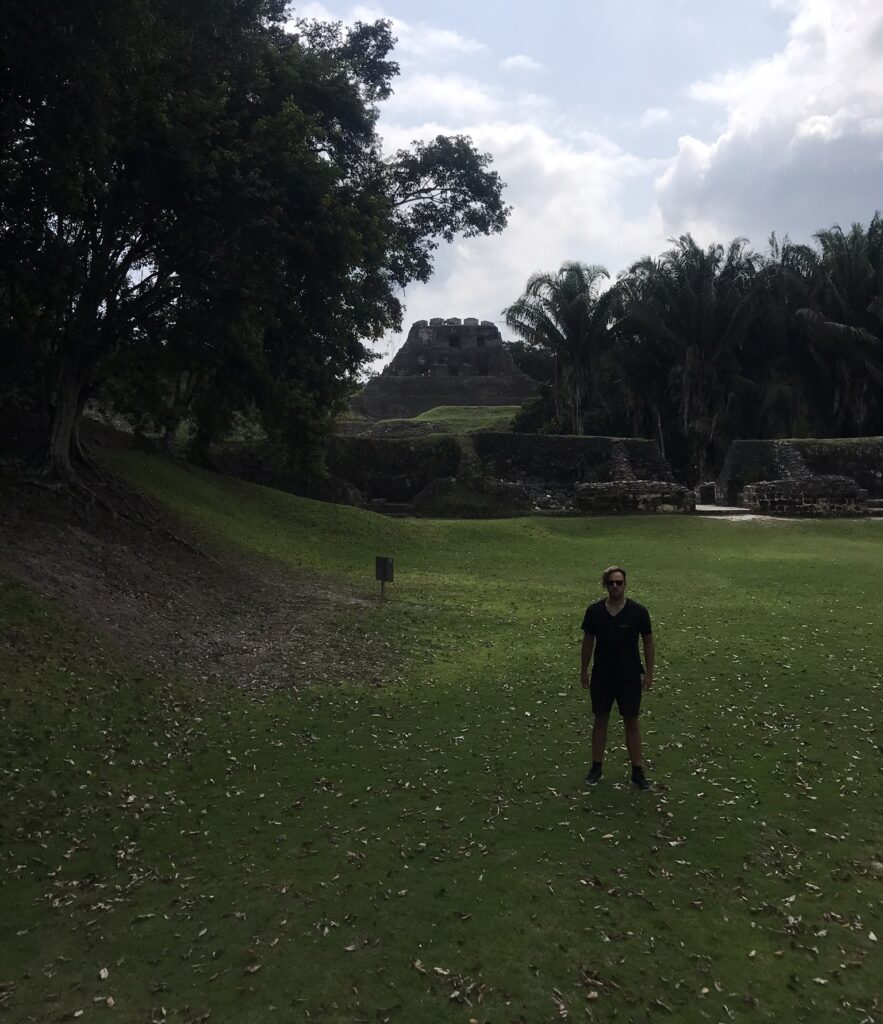
Dan at the Xunantunich Mayan ruins near San Ignacio, one of a number of impressive Mayan sites in Belize
Along the highways throughout Belize we saw lots of land for sale in green remote areas. After visiting I couldn’t stop looking at real estate companies and house prices because I liked it so much!
Belize City
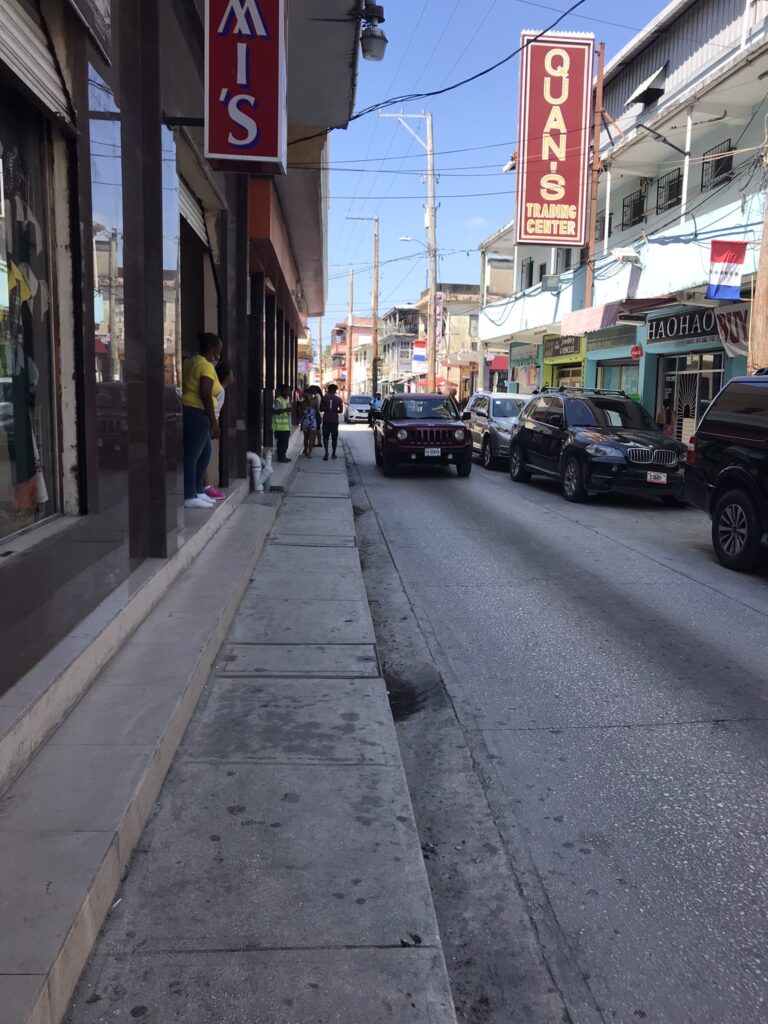
Belize City is the former capital of Belize and the country’s biggest city. Despite its interesting British colonial history, Belize City isn’t a place that many visitors speak highly of. Most of the historical buildings were wiped out by a hurricane in the 1960s. The city has a bad reputation for crime and most outsiders who do visit tend just to be passing through on the way to the popular tourist destinations of Caye Caulker or San Pedro, which are both accessible by boat from Belize City. Buses run to Belize City from all parts of the country as well as from Quintana Roo in Mexico.
We spent a night in Belize City after getting the direct bus from Bacalar in Mexico. The bus terminal is located here in Belize City, on the south side of town. Belize City is divided in two by the Haulover Creek which runs through the centre of town. While the south side has a bad reputation, in daylight hours it is safe enough to walk from the bus terminal along Orange Street and over the swing bridge to the north side of town. The north side (north of the river) is generally considered to be the safer of the two, and is where most of the gringos from our bus were heading as it is the departure point for ferries (water taxis) to the islands.
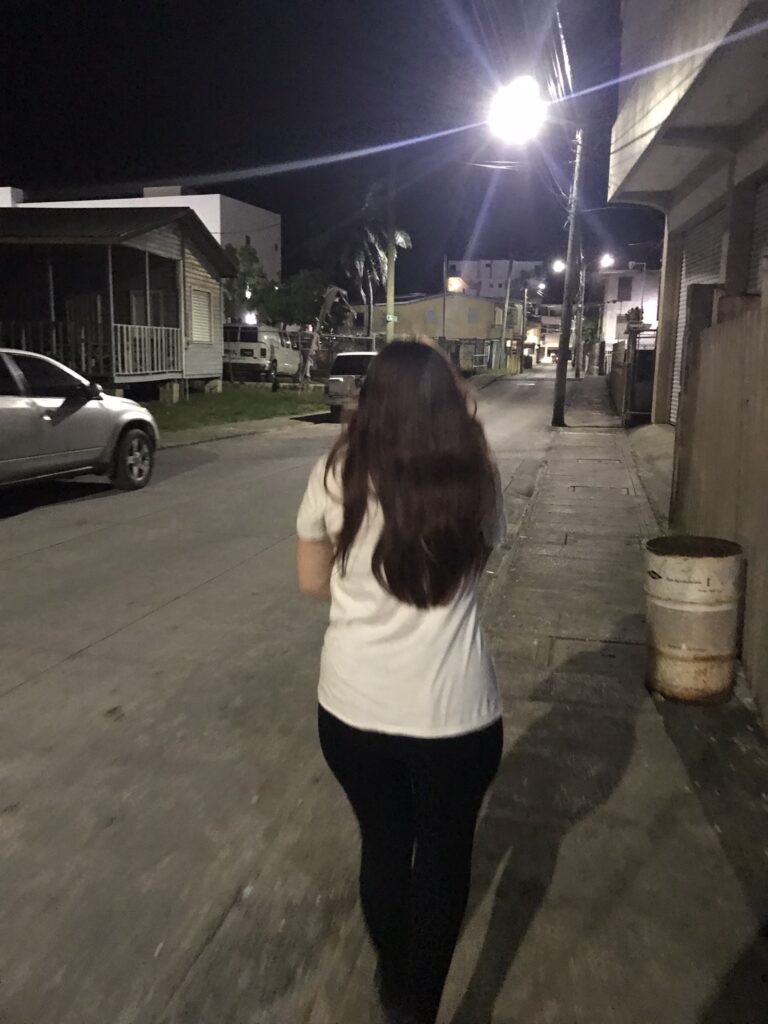
Out after dark in Belize City
We found that Belize City, while not for the faint of heart, had a typical and distinctive Caribbean culture. While its bad reputation among rich tourists is probably justified, we didn’t encounter any problems and met plenty of friendly and helpful locals in our short time in the city. We didn’t explore too much though as we were only there for one night and we didn’t want to go out too much after dark.
If you head to Belize City by bus and want to immediately get a water taxi to the islands then make sure to check the time of the last boat, otherwise you might end up stranded for the night. The ferry dock is over a kilometre from the bus terminal and our bus from Mexico arrived only 20 minutes before the last boat was set to depart, quite a few people went immediately sprinting off towards the ferry port to try and catch the boat and I’m not sure if they made it or not.
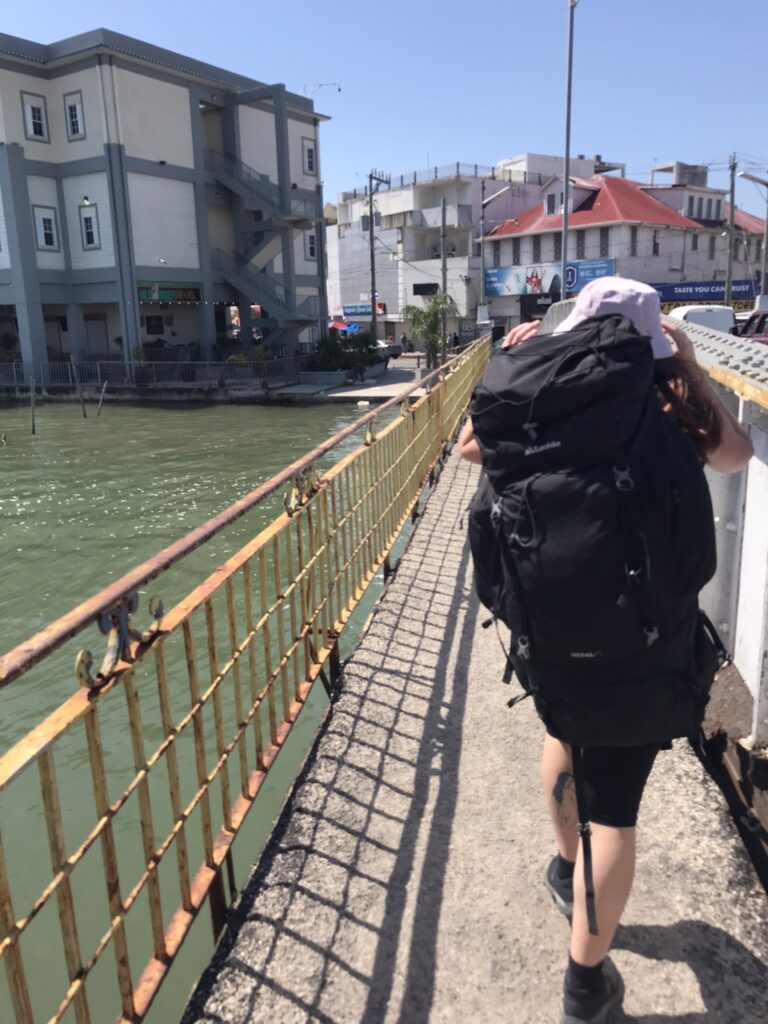
The Swing Bridge across Haulover Creek separates the north and south sides of Belize City
Accommodation
Bella Sombra guest house – suitable for a one-night overnight stay, it was pretty basic accommodation but safe enough and walkable from bus station and ferry docks. The employee who let us in randomly only spoke Spanish, which we didn’t expect in this part of Central America.
Foodie places
Nerie’s – we enjoyed the typical Belizean dish of chicken, rice and beans. The people here were welcoming and super friendly and the food was very tasty. This is a bar as well as a restaurant, we were the only people eating upstairs and got chatting to a local older man and lady who said they visit Nerie’s every week to sing karaoke. We enjoyed talking to them about the city and country, at one point the lady’s daughter showed up to sing karaoke and was really ridiculously good. From the safety of the upstairs balcony we could see unruly kids roaming the streets outside, some of whom were known to the singing duo. This was definitely an authentic local experience.
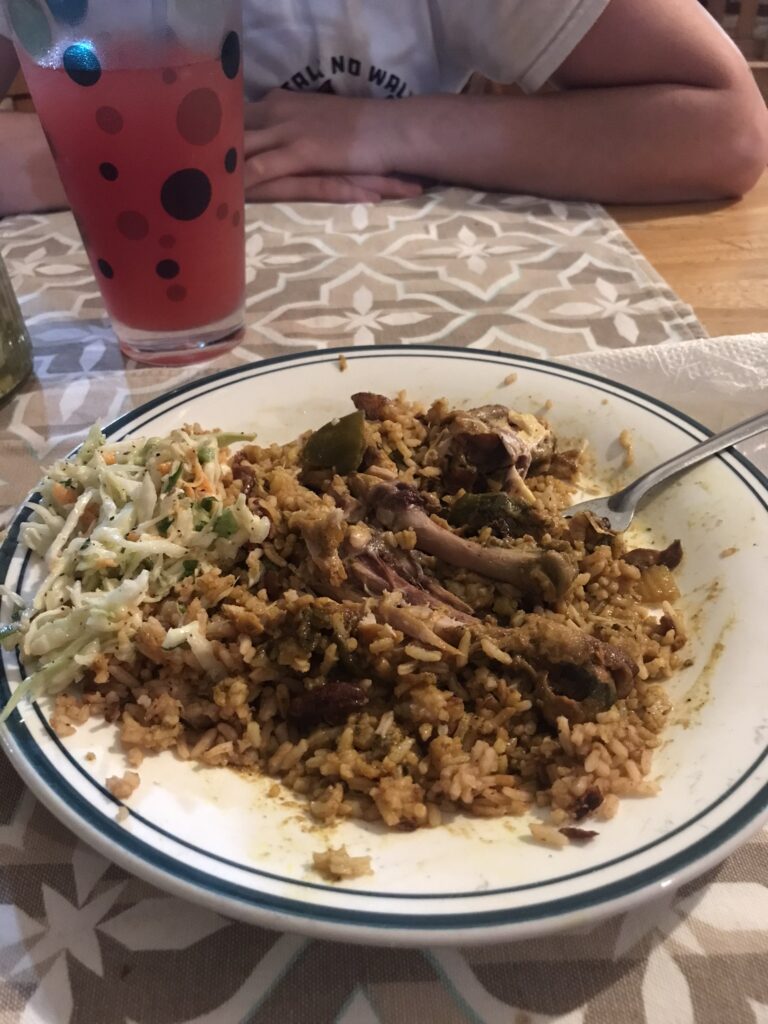
Classic Belizean food at Nerie’s
Dario’s Meat Pies – a Belize City institution. We showed up first thing in the morning to get pies for breakfast and got stuck in a really long queue of people collecting bulk batch orders to take back to their families or communities. Eventually a helpful lady in the queue told us that Dario’s also has a street stand a few blocks away selling individual pies which are the same as those in the shop. This saved us a lot of time. The pies are pretty small but tasty and filling, get a few.
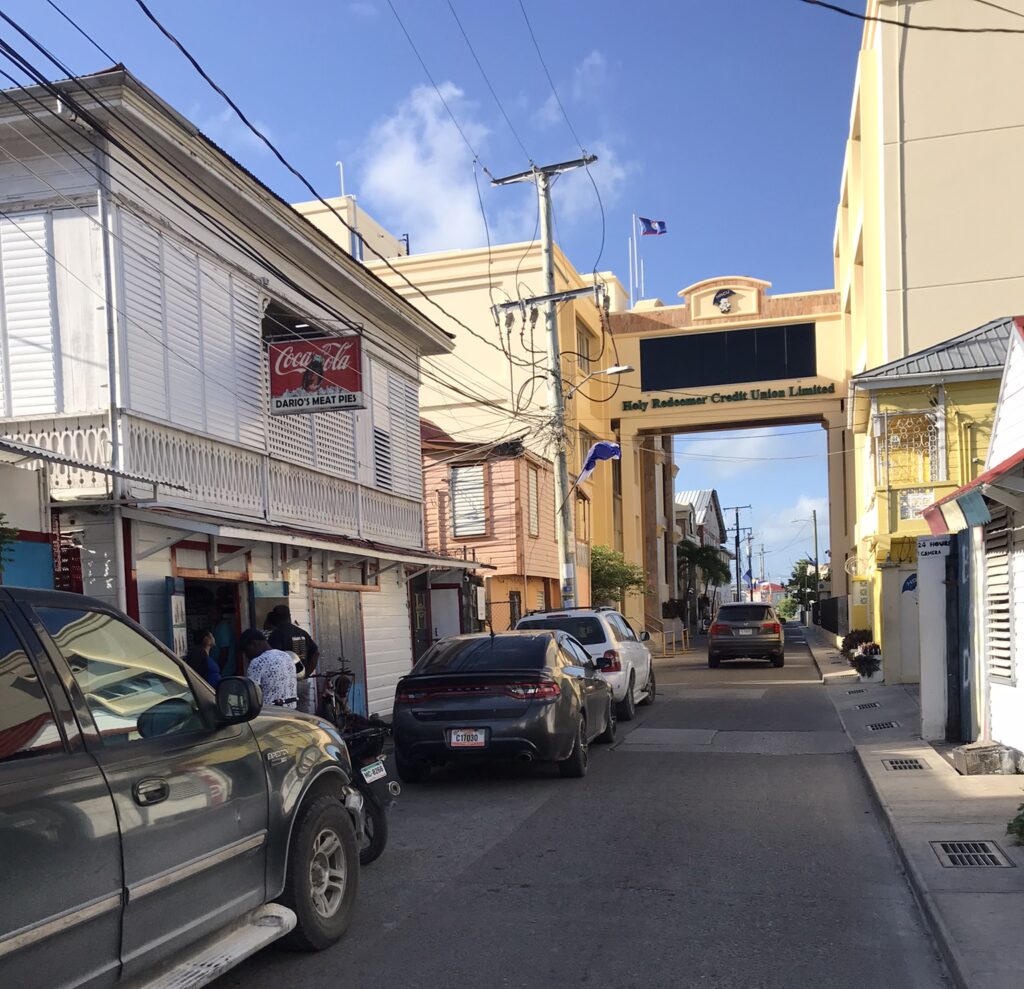
Dario’s pies are a Belize City classic, but this isn’t the only place to get them
Activities
Water taxi to Caye Caulker – not exactly an activity in Belize City itself, but the water taxi to the islands is probably the main draw for most visitors here other than maybe a quick look around the north side of town in daylight hours. The San Pedro Express water taxi has a modern and safe terminal building with some shops and cafes, there is also a luggage check-in area. Boats go to both Caye Caulker and San Pedro and tickets can be bought either online or at the ticket office in the terminal.
Caye Caulker
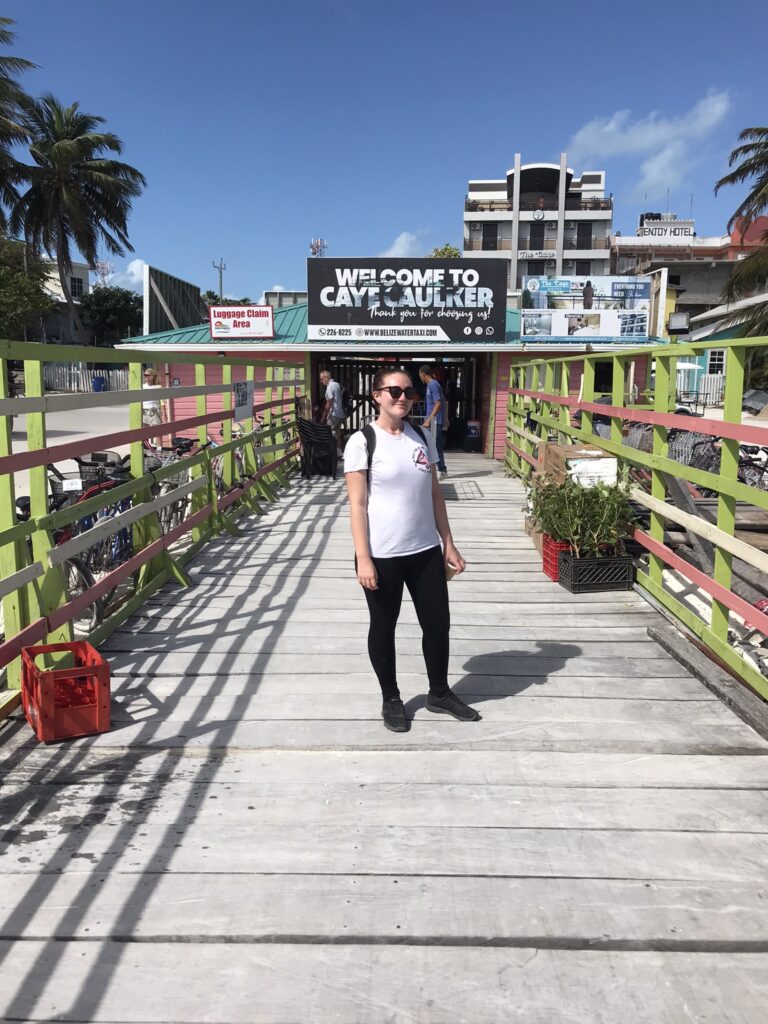
Caye Caulker (pronounced ‘Key Caulker’, people will scoff if you get it wrong) is one of two major island tourist hotspots in Belize, the other being Ambergris Caye with its main settlement of San Pedro. Both Caye Caulker and San Pedro can be accessed by boat via ‘water taxi’, which is basically a speedboat-style ferry. Water taxis depart from the mainland at both Belize City and Chetumal in Mexico, and will usually call at both islands. You can find the water taxi schedules here.
Both Caye Caulker and San Pedro are major tourist destinations due to their idyllic island settings, Caribbean vibes and proximity to the Belize Barrier Reef, the second largest coral reef in the world. Tourism makes up almost all of the economic activity on Caye Caulker. The main things to do on the island are drinking at Caribbean-style beach bars, swimming in the sea and going on snorkeling trips. The island’s motto is ‘go slow’ – people said this to us immediately while we were charging around with our bags when we arrived from the water taxi, and it definitely sums up the laid-back lifestyle of the islanders. It also applies literally as there are not many cars on the island. Golf buggies are available for hire to tourists but the whole island is easily walkable.
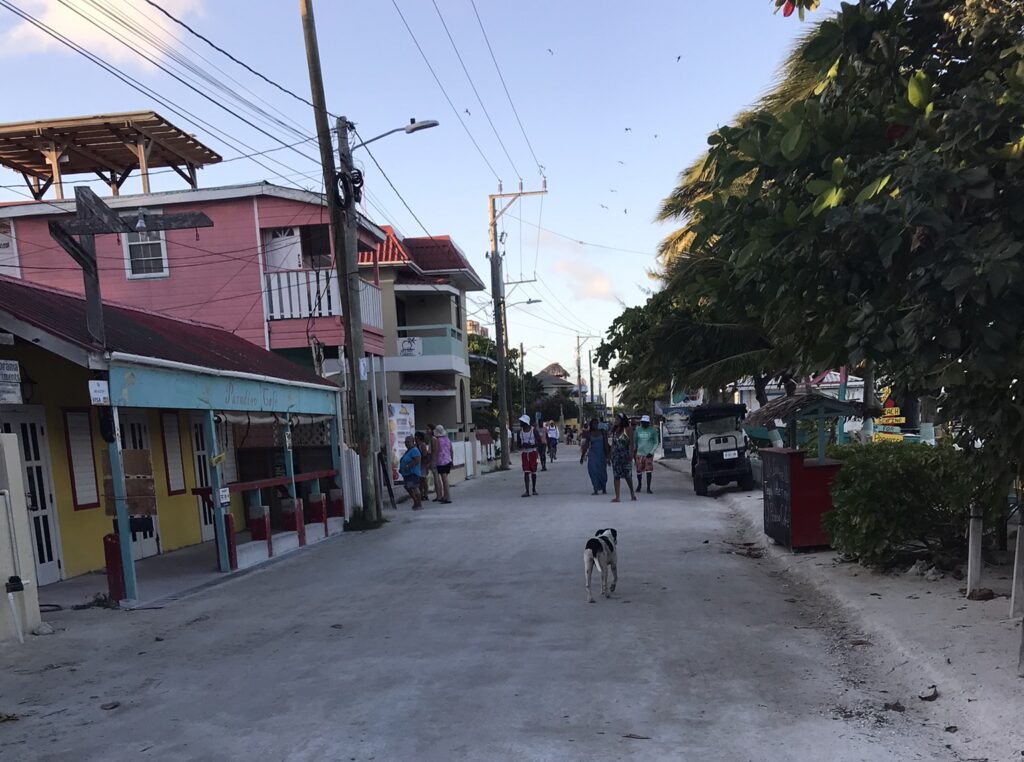
This is the main street on Caye Caulker – you won’t find many cars here!
Caye Caulker actually consists of two islands separated by a small channel known as ‘the split’. The south island is by far the more developed of the two, containing most of the island’s infrastructure including the main port. The north island is much more secluded, containing only a few luxury establishments and resorts which are mostly accessed by private boat. Most of the north island though is just undeveloped swampland which is left to nature. It’s possible to take a small boat across the split to explore the north side, but beware that there are crocodiles in the swamps!
The south island of Caye Caulker is where most of the action is. The main street on the south island is on the east side, running north to south along Playa Asuncion. Along this street you can find the main port, hotels, restaurants and bars, lots of tour agencies selling snorkeling and diving trips as well as high-end BBQ places such as ‘Chef Kareem’s Un-Belizeable Lunch’. You can’t miss these BBQ places because of the smell and the smoke. While it just looks like a bunch of guys grilling at the side of the road, these places are actually relatively expensive and highly acclaimed, serving fresh crab and lobster etc.
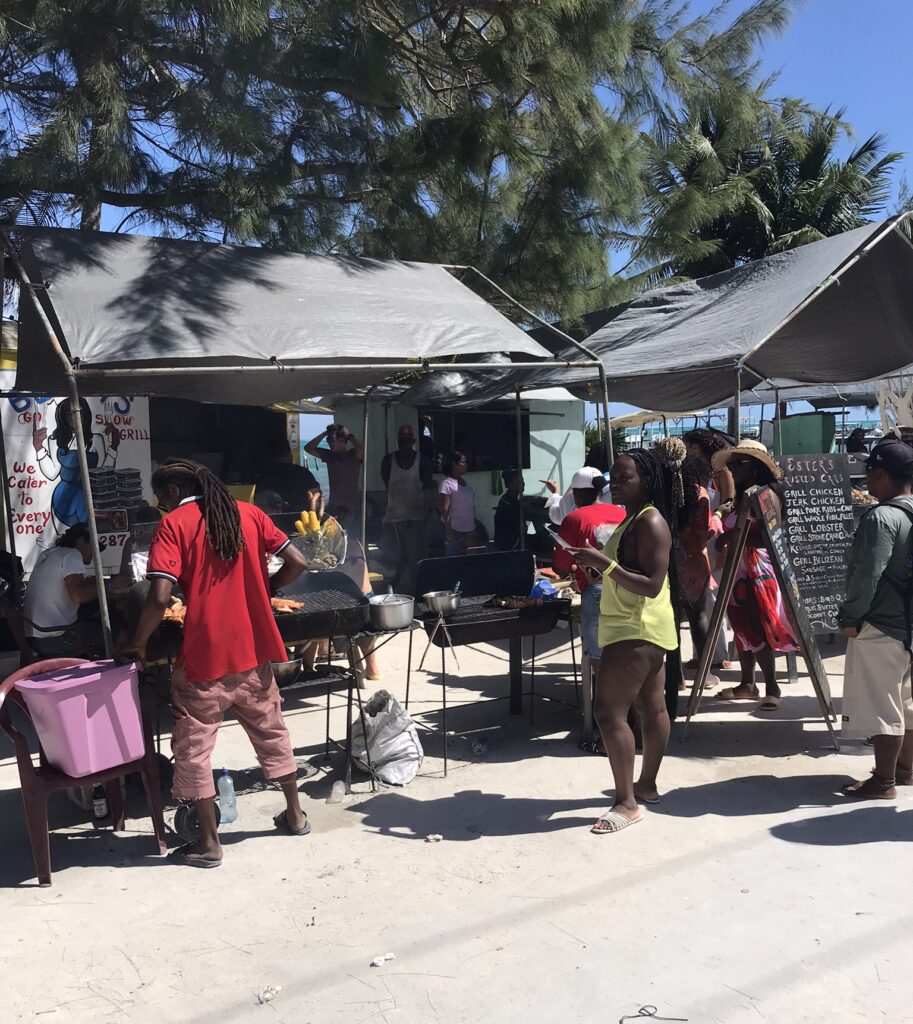
These roadside grill stands are the real deal
A focal point of the island is the area around the split, which consists of a lot of bars and swimming areas including the famous Lazy Lizard bar with its popular (and very alcoholic) slushy green cocktail ‘Lizard Juice’. Serving both food and drinks, this area contains a little inlet for swimming complete with floating rafts and a high jumping platform into the sea. It is possible to sit at a table in the sea and eat food/drink cocktails. Lazy Lizard is also a good place to go to face west and watch the sunset while sipping on a cocktail. Small boats across the split to the north island leave from a small dock next to the Lazy Lizard.

Lizard Juices at sunset
Accommodation
Caye Caulker Plaza Hotel – a comfortable enough hotel. They had a watercooler which always had fresh water available, and the rooms had pretty good aircon which was a big plus.
Foodie places
Auntie’s Takeout Food – quite a basic takeout-only place serving typical local food such as fryjacks. Heavy and hearty food. One of the better value options on the island, plenty of locals were eating here
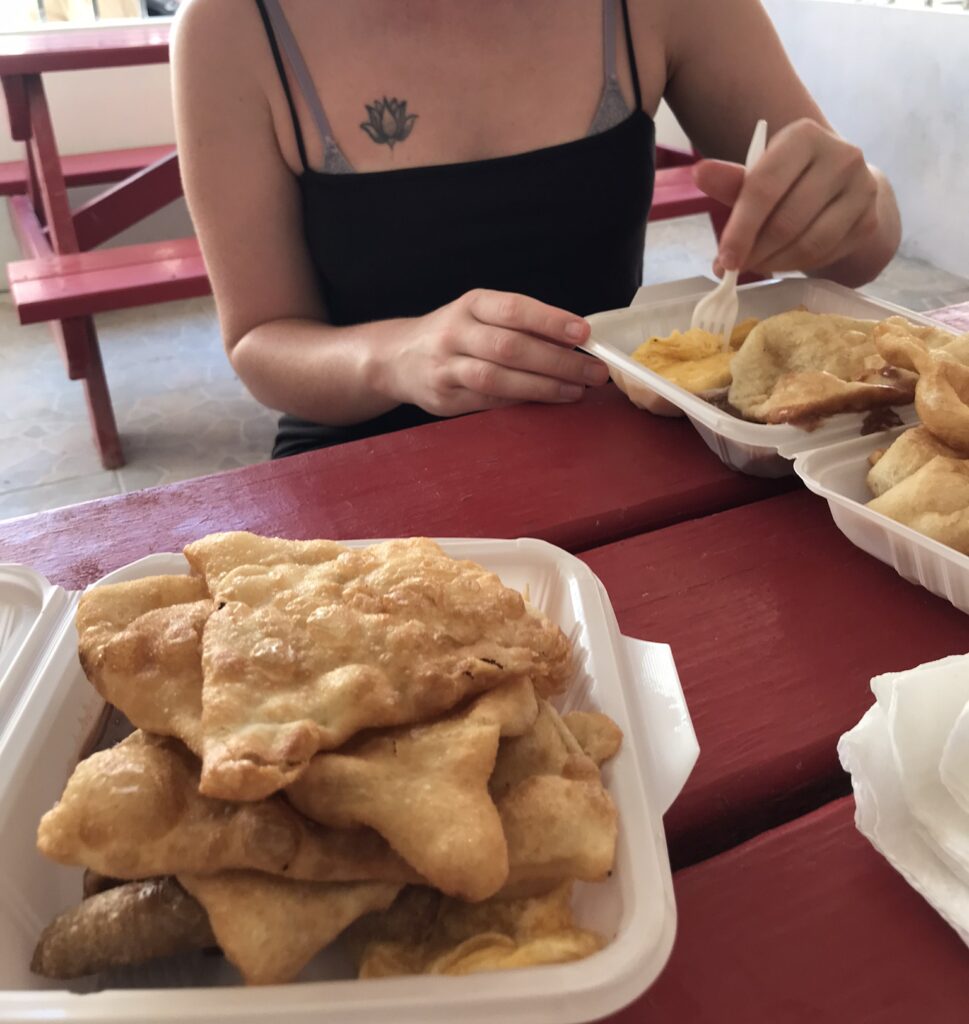
Fryjacks are a breakfast staple on the island
Chef Juan’s Kitchen and Pastries – off the main street so prices are a little lower, this place serves a decent range of mainly local-style food. It has a beach shack feel, you order at the kiosk and eat on picnic benches outside but the food is restaurant-quality. We liked the beef brisket and the key lime pie. The workers here were very friendly too. We went back multiple times
Tapper’s Dive Bar – a popular bar which also serves food, we really enjoyed the quesadillas. We watched the Super Bowl here and enjoyed the atmosphere.
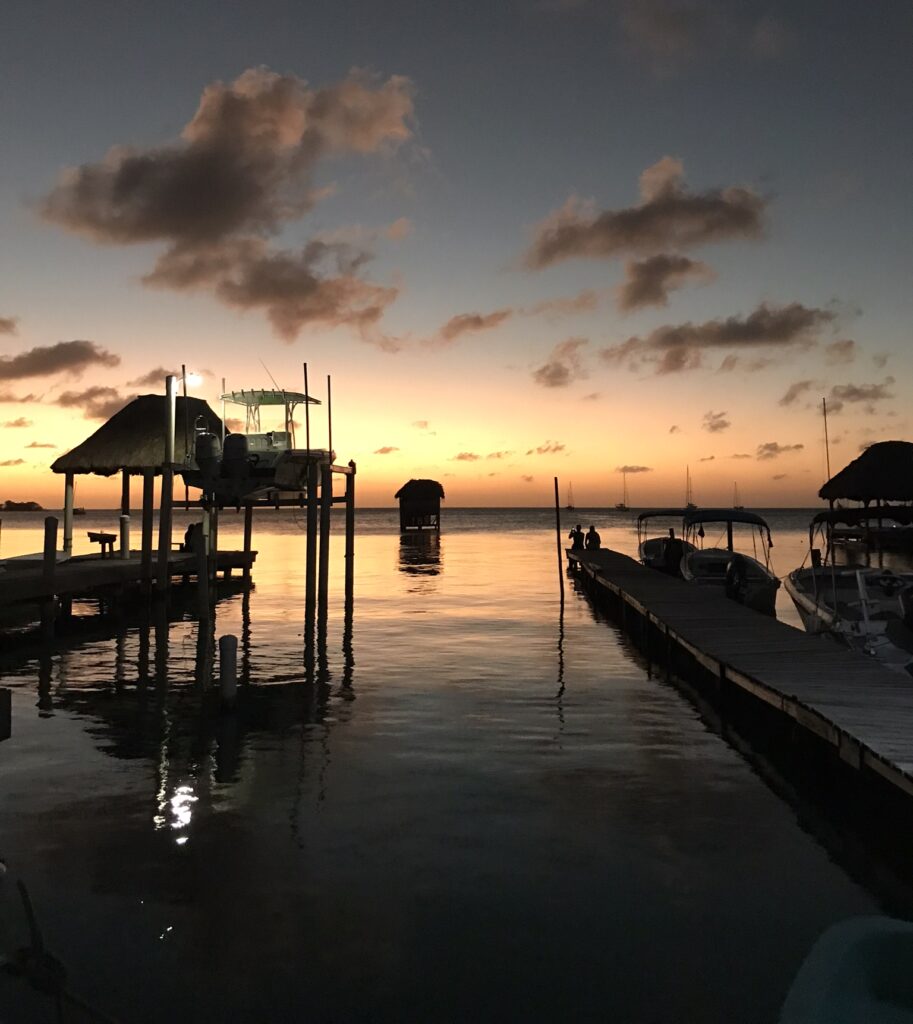
Sunset from the west side of the island
Activities
Snorkeling tour with Blackhawk tours – we booked this tour from one of the many agencies on the island. The snorkeling tours are a little expensive but it’s worth the price to visit the nearby Belize Barrier Reef and Hol Chan Marine Reserve, which are some of the largest and most important undersea coral habitats on earth and an amazing sight. The tour took us right out to sea in order to reach the coral barrier and marine reserve. Interestingly we had to stop at a floating platform in the middle of the sea to get our wristbands to enter the Hol Chan reserve.
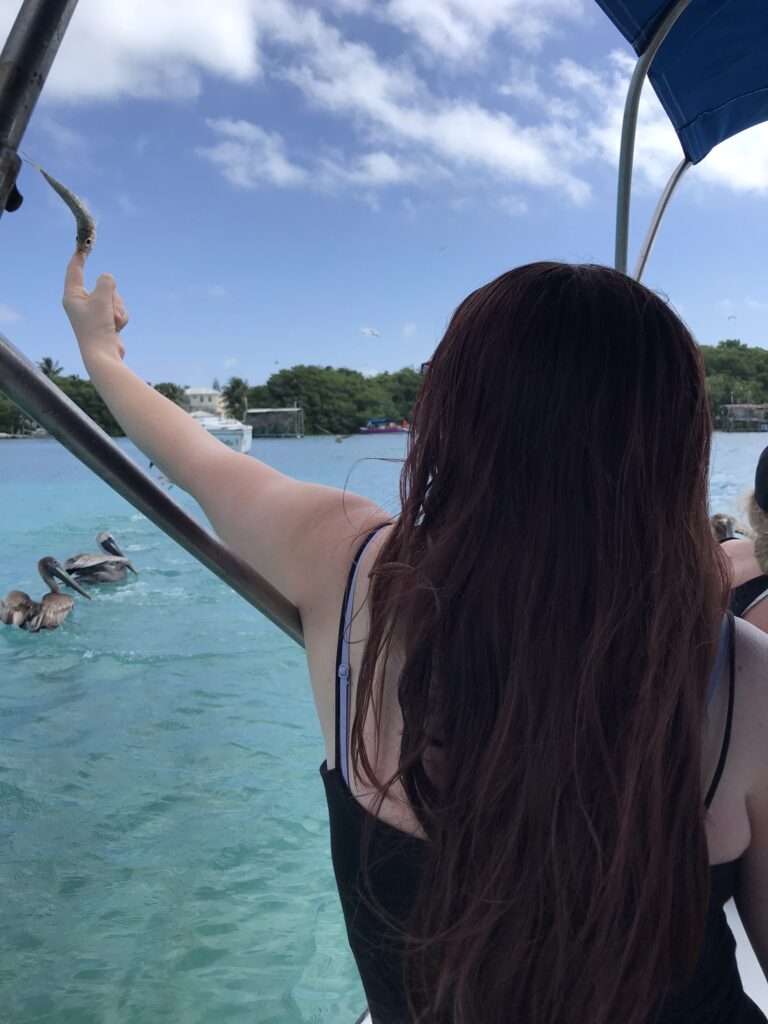
Feeding the seabirds – this actually works!
This was a great snorkeling tour, as well as the coral we saw, swam with and even fed a lot of wildlife including nursing sharks. The local guys operating the tour were very funny and laid back, chatting and answering questions with a good sense of humour. The included lunch was great and free juice or alcoholic punch was also provided. As well as the snorkeling we also went to Tarpon View to hand-feed tarpons which jumped out of the water for the food, we hand-fed seabirds from the boat and even briefly docked on the north island to look for crocodiles. The tour company even let us try out the snorkel equipment for free beforehand, and went out of their way to make sure the equipment worked so we could enjoy the tour.
Don’t eat fryjacks right before going on the snorkeling trip! We had a heavy breakfast which wasn’t a great idea just before getting on the boat.
Tarpon View – a small dock on the west of the island where it is possible to feed tarpons, which will jump out of the water to take the food from your hand
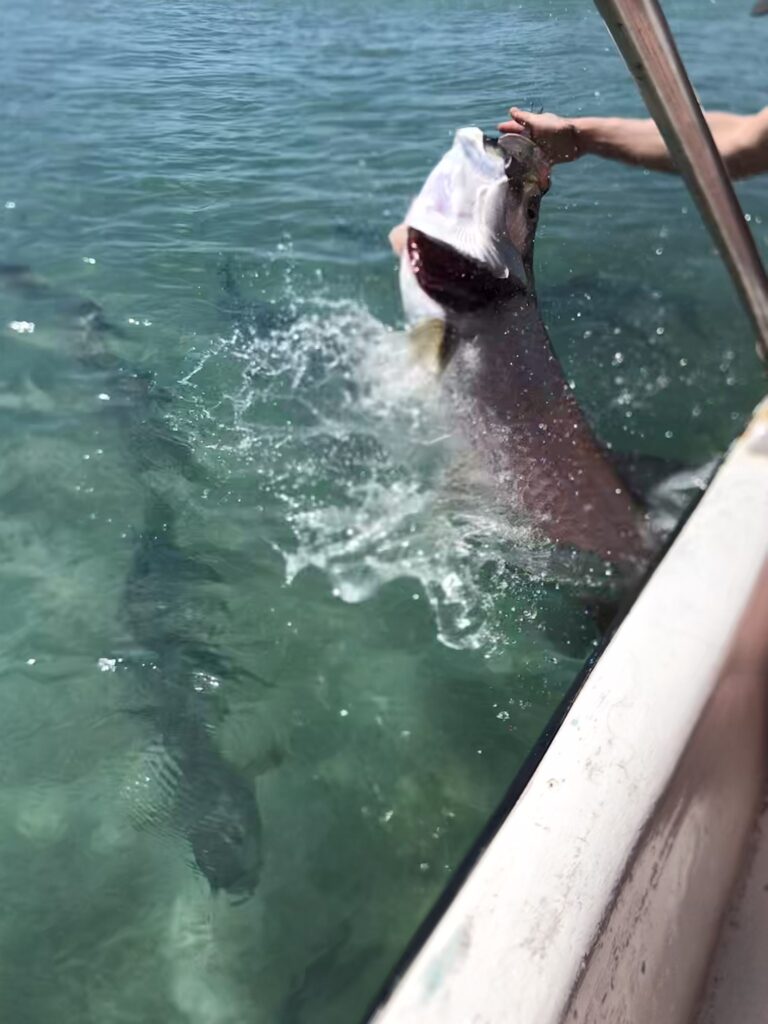
A flying tarpon
Belmopan
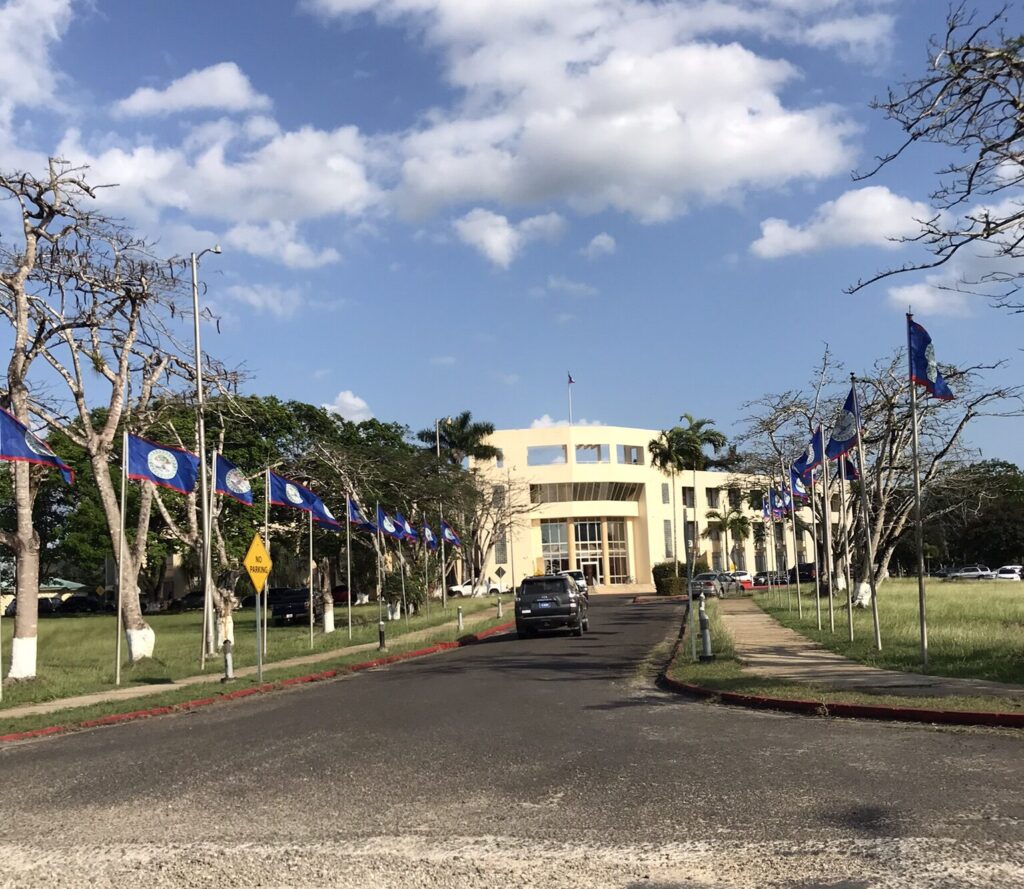
Belmopan, the capital of Belize, is located in the middle of the country along the main road from Belize City to San Ignacio. Although it is the third largest settlement in Belize by population, Belmopan is one of the smallest capital cities in the world. It replaced Belize City as the capital in order to create an inland base that was not vulnerable to damage from hurricanes, however Belmopan’s inland location away from the coastal breeze makes it extremely hot and humid. Due to Belmopan’s unfavourable location and climate, quite a few government and overseas diplomatic buildings still remain in Belize City. However the government of Belize has made a concerted effort to relocate its administrative buildings to Belmopan and most major embassies have followed suit.
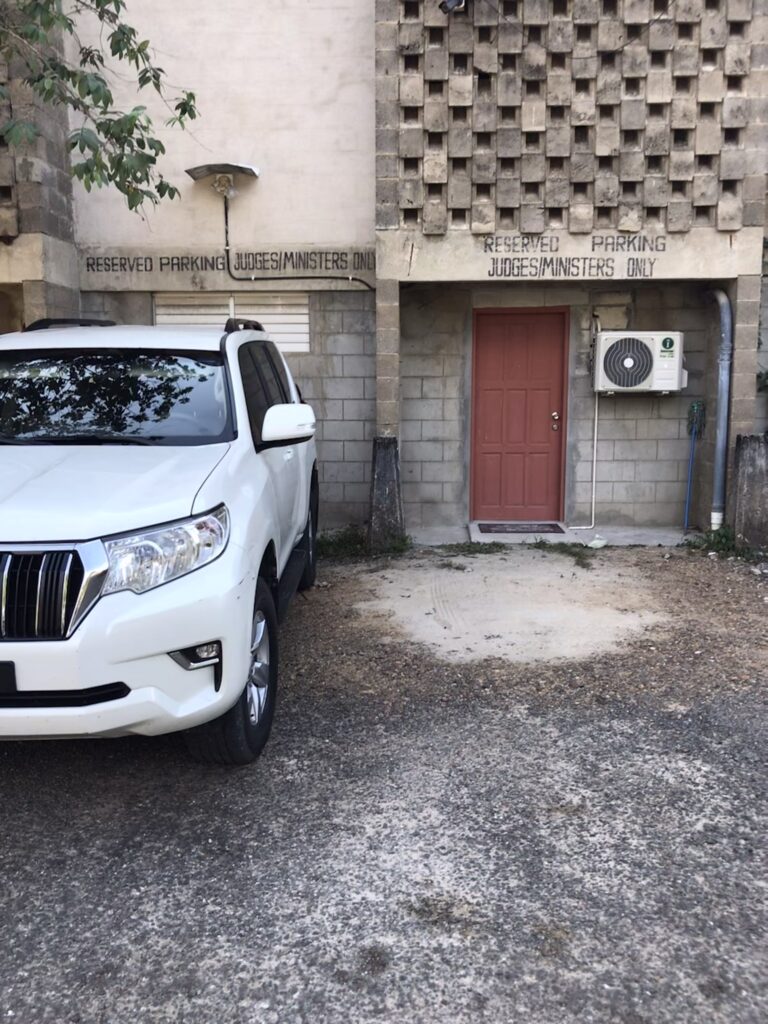
Don’t worry, we didn’t park here
We stopped off in Belmopan for a few hours to have lunch and have a walk around. There is not a huge amount to see in Belmopan apart from the embassies and government buildings, but it was pretty interesting to be in such a small capital city. Guanacaste National Park is nearby, it’s a small national park with walking trails which is within walking distance of Belmopan city centre. We didn’t visit but it might be something to do if you have more time in Belmopan I guess.
Foodie places
Caladium restaurant – a slightly upmarket restaurant near the bus station, this place serving typical Belizean and international dishes was a nice enough stop for lunch. The aircon here was a great reprieve from the intense heat and humidity. They even let us store our bags in the restaurant for an hour while we had a look around the city, which was much appreciated as it was baking hot and would’ve been pretty uncomfortable carrying our bags around in the heat.
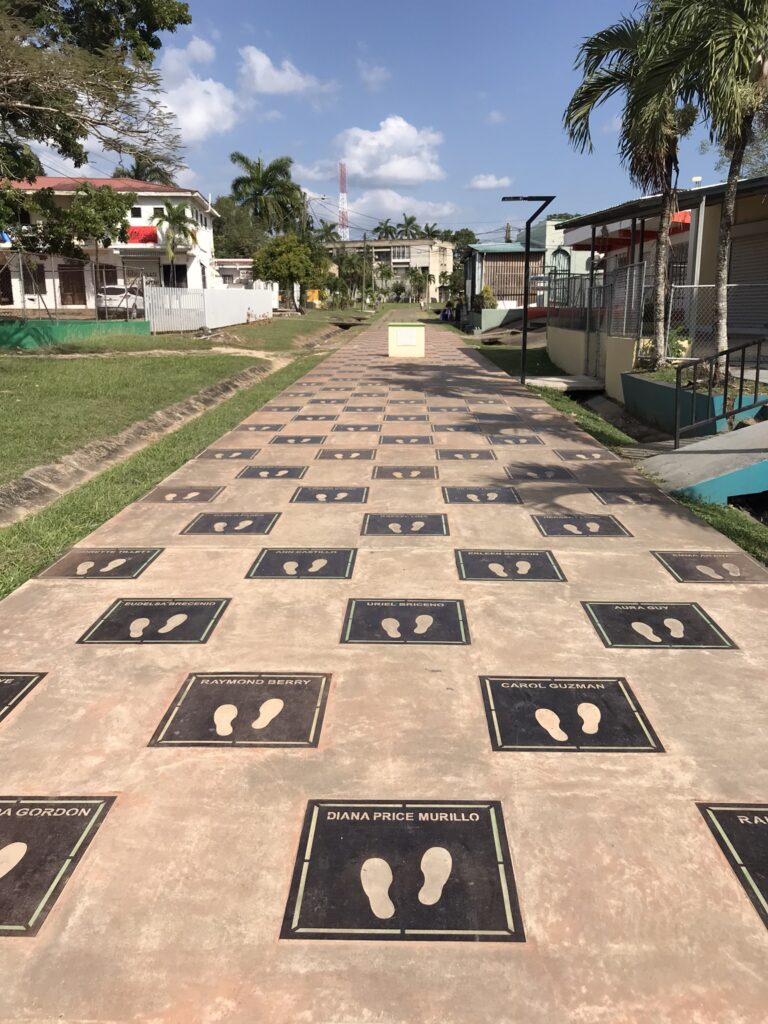
The Belize Walk of Recognition is just around the corner from Caladium – unlike in some other countries, this walk of fame honours public servants rather than celebrities
Activities
We took a quick walk around the city centre. Most of the administrative buildings and embassies are clustered together in only a couple of blocks so it’s easily walkable in less than an hour. Highlights are the Belize Walk of Recognition, the British High Commission, the residence of the Governor General, the US Embassy, the Ministry of Public Service, the Assembly Building and a load of other government ministry buildings. If you aren’t interested in this type of thing then there probably isn’t much for you to see in Belmopan.
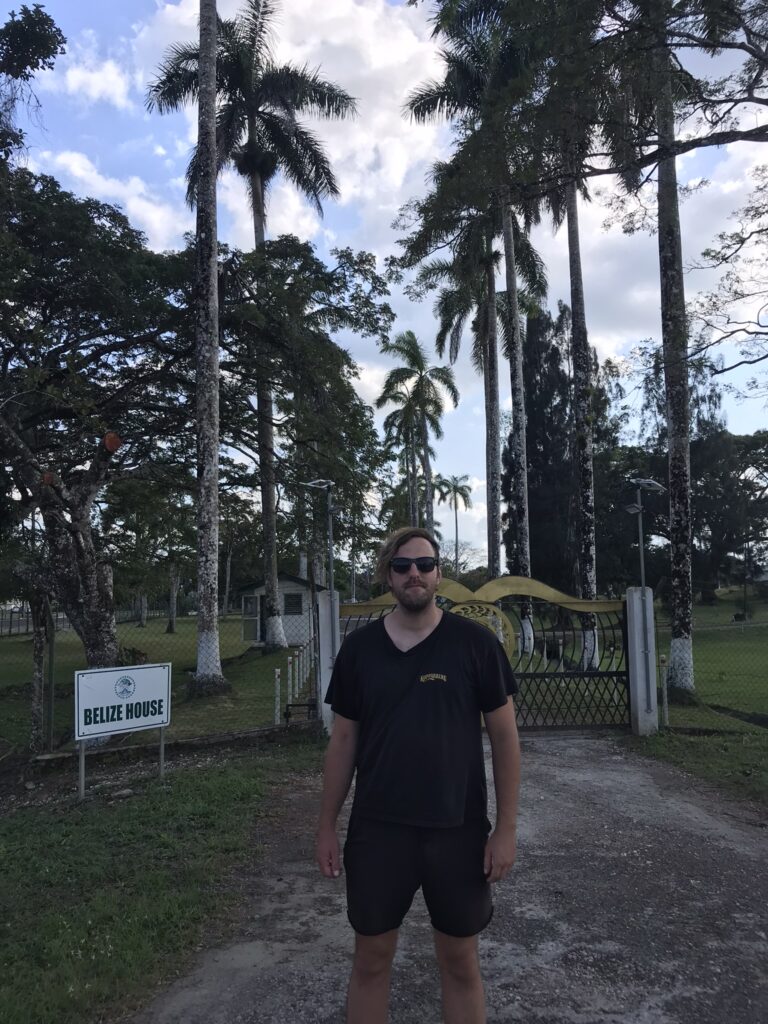
Belize House, the residence of the Governor General. The Governor General playing field is right next door
It was quite cute to see a number of the embassies next door to each other in one part of the town, you can imagine the ambassadors of various countries all hanging out together. You can do a little walk around the streets to see the different embassies and look at the houses, don’t go too close though as you might get in trouble with the security guards.
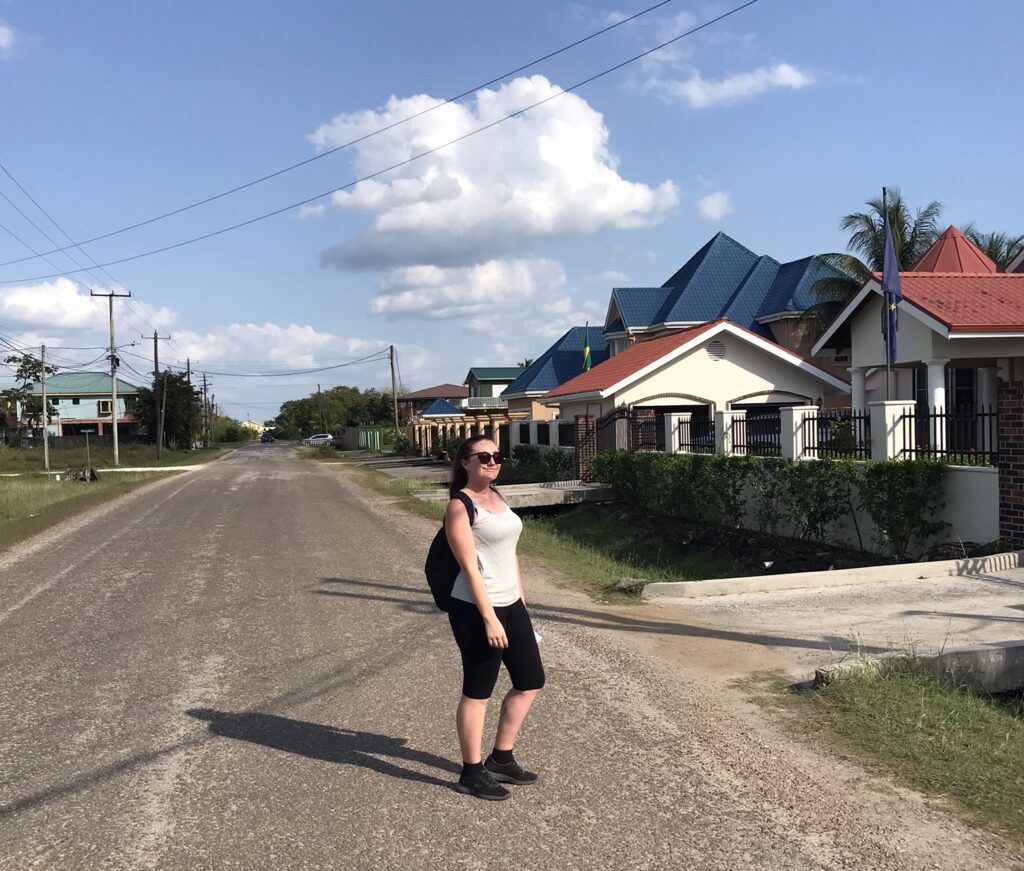
An EU embassy next door to the embassy of Brazil
San Ignacio
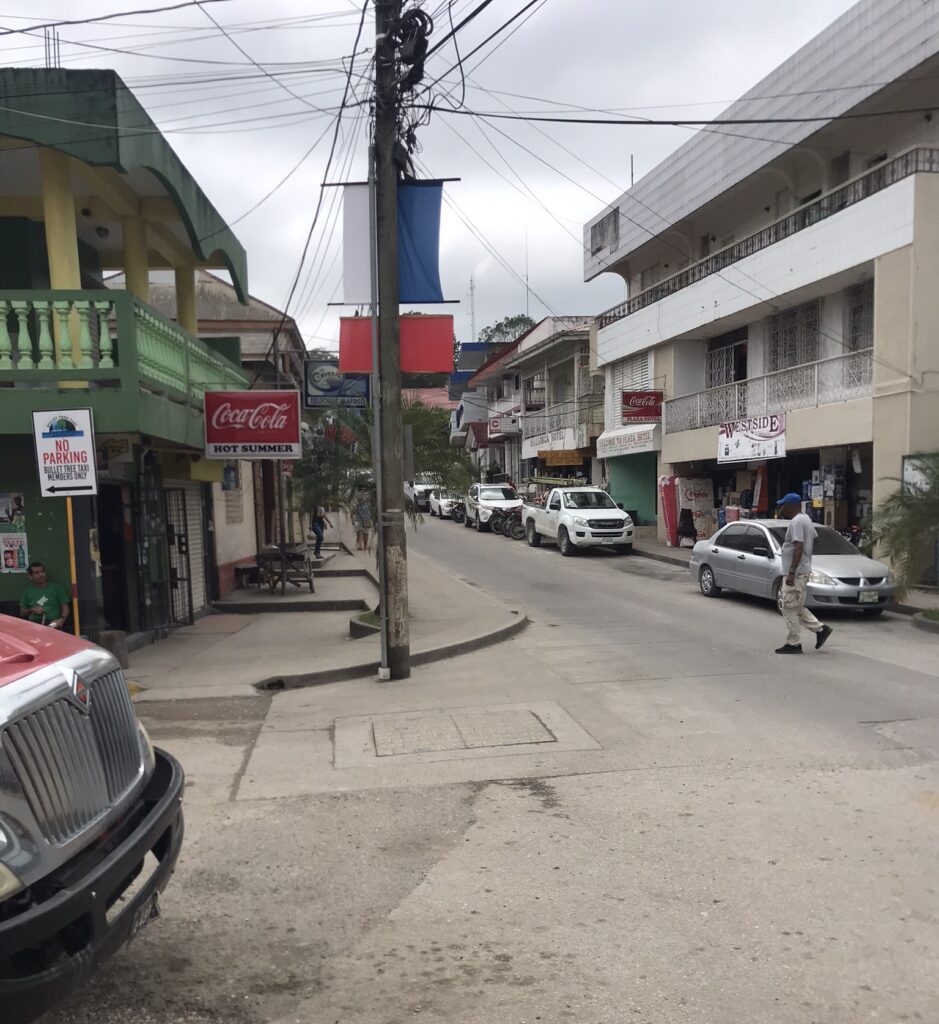
The second largest settlement in the country after Belize City, San Ignacio is close to the Guatemalan border and culturally has more Mayan influence than the coastal areas. Spanish is more widely spoken here than in other parts of the country, but we also found it interesting to meet Mayan people who were native English speakers and spoke English with a typical Caribbean accent.
While it would be considered a small town elsewhere, San Ignacio is a major hub by Belize standards. The large central market next to the river is the focal point of the town. We bought eggs, washing power and some not very nice mayonnaise from the market. There were lots of small settlements and homesteads on the outskirts of town and along the main road, with many others under construction on large green spacious plots. The real estate market in this part of Belize seems to be booming with plenty of land for sale.
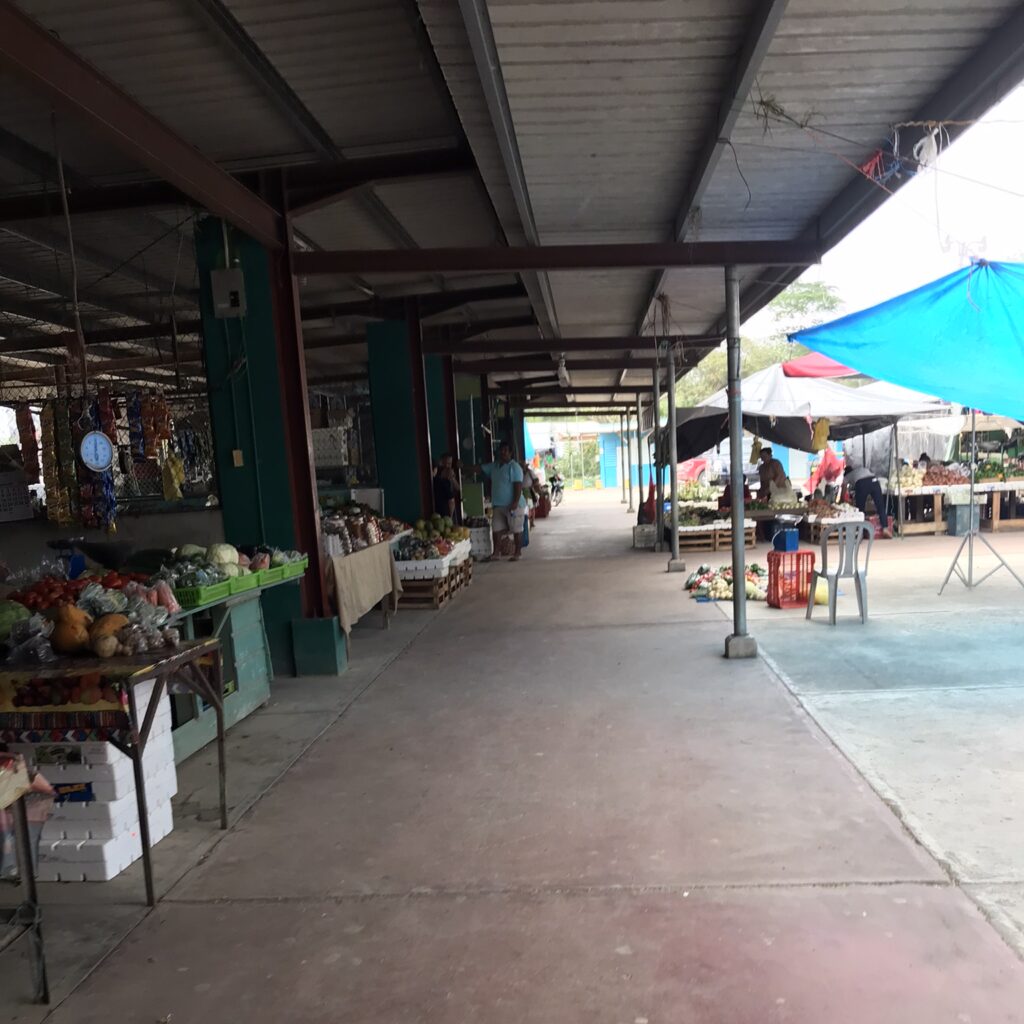
Plenty of fresh produce is available at the market in San Ignacio
In Mayan times, the population of the region surrounding San Ignacio was larger than the whole of modern-day Belize. As a result, San Ignacio and the wider Cayo region is home to an abundance of Mayan ruins. Archaeological sites such as Xunantunich and Cahal Pech are easily accessible from San Ignacio independently, while others such as Caracol are impossible to access using public transport. The most popular Mayan site in the area is Actun Tunichil Muknal (ATM Cave). This is only accessible through a relatively expensive guided tour which involves swimming, climbing and crawling to reach a sacred Mayan cave. While it seems like a great adventure, we couldn’t really justify the cost of the tour. It would probably be a great experience for short-term travelers or people with a bigger budget.
Accommodation
Don Santiago – pretty small guesthouse with a very friendly owner who helped with local tips and advice, there was a well-stocked kitchen and we were able to do laundry here. The property had a veranda area to sit and overlook the road which was nice. Unfortunately we were unlucky and had a room next to the kitchen which was noisy in the morning, however this was a nice place overall.
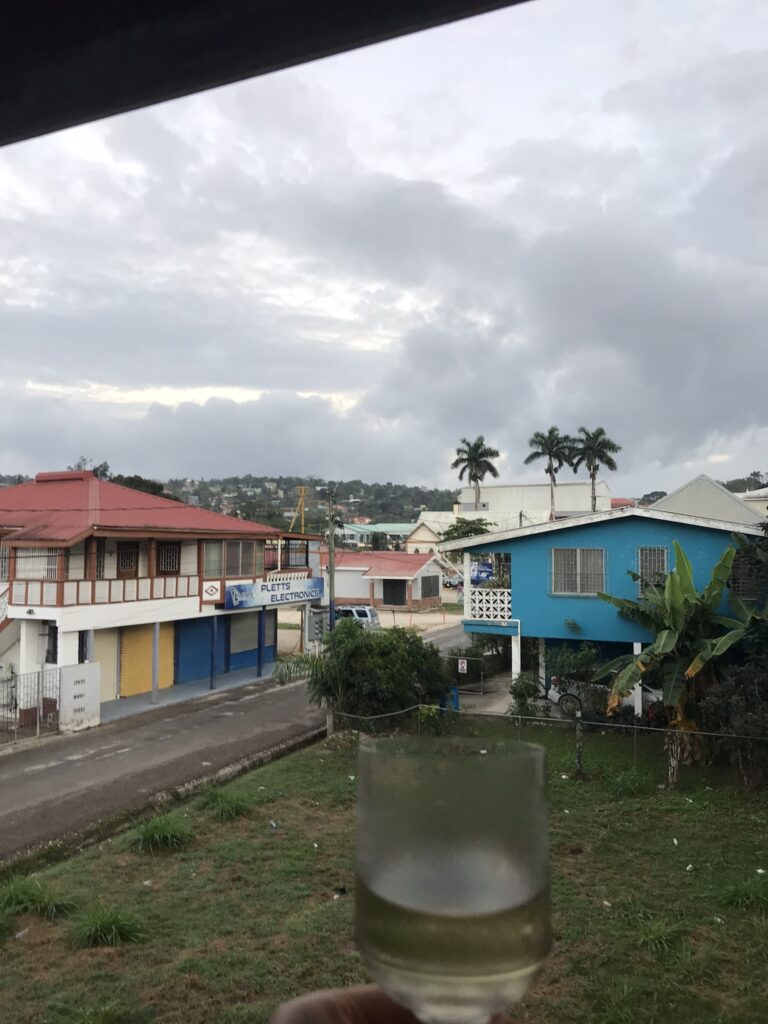
Enjoying a glass of Mexican wine on the balcony at Don Santiago
Foodie places
The New French Bakery – we got lunch here every day, the takeaway pizza made for a cheap and easy takeout lunch. We sometimes got breakfast here too. The quality and price couldn’t be beaten!
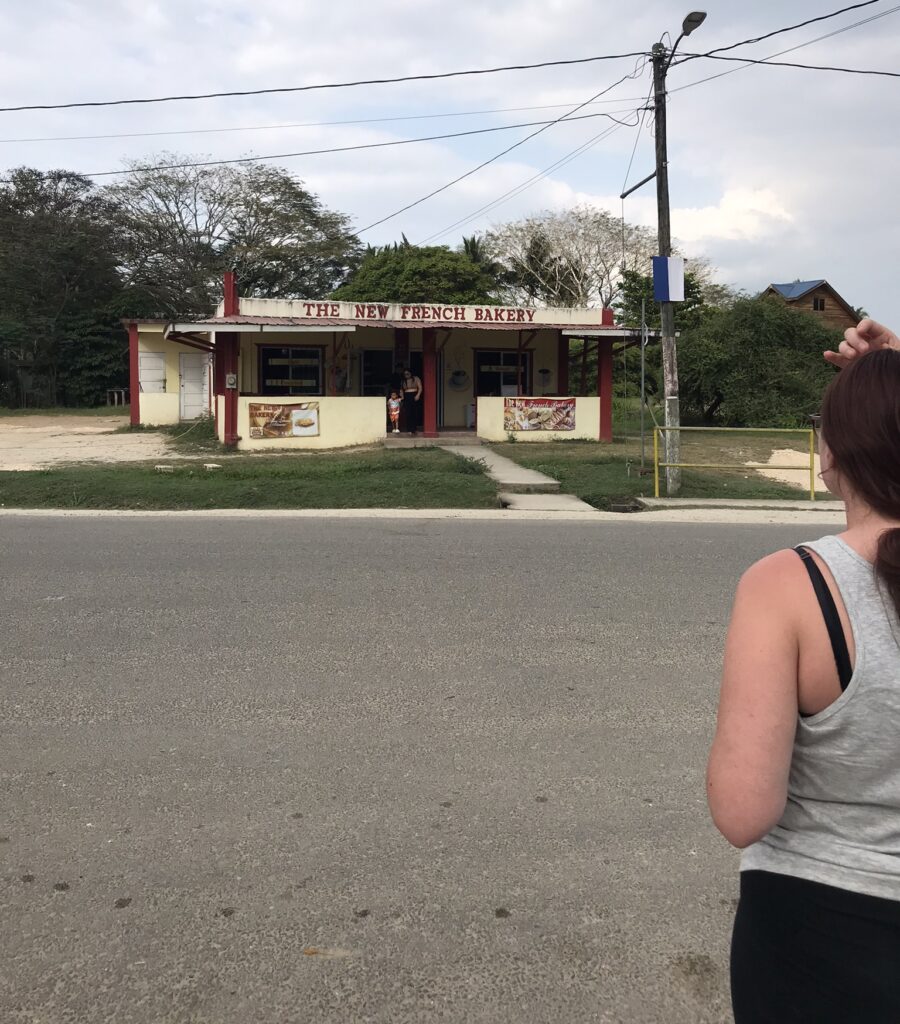
French bakery is maybe a stretch but this place does good takeaway pizza slices
Ko-Ox Han Nah (Let’s go eat) – we went for Valentine’s Day. A very popular restaurant, we had to wait outside for a while before getting a table. The lamb burger and mashed potato were delicious
Quality Foods – a huge modern supermarket with a great range of products including a freezer section, baked goods section and an array of international products that we didn’t see anywhere else in Belize or Central America. Strangely, the supermarket was completely empty and devoid of customers when we visited. Other than the staff we were the only people in the whole shop.
Activities
Xunantunich Mayan Ruins – Xunantunich is a fairly large and well preserved Mayan site. It features some very tall temples which you can climb, the largest of which is actually the second tallest building/manmade structure in Belize (the first is also an ancient Mayan temple, at Caracol). There is an impressive view over the canopy from the top of this temple with views into Guatemala, however there aren’t any safety barriers so it’s not so great if you don’t like heights!
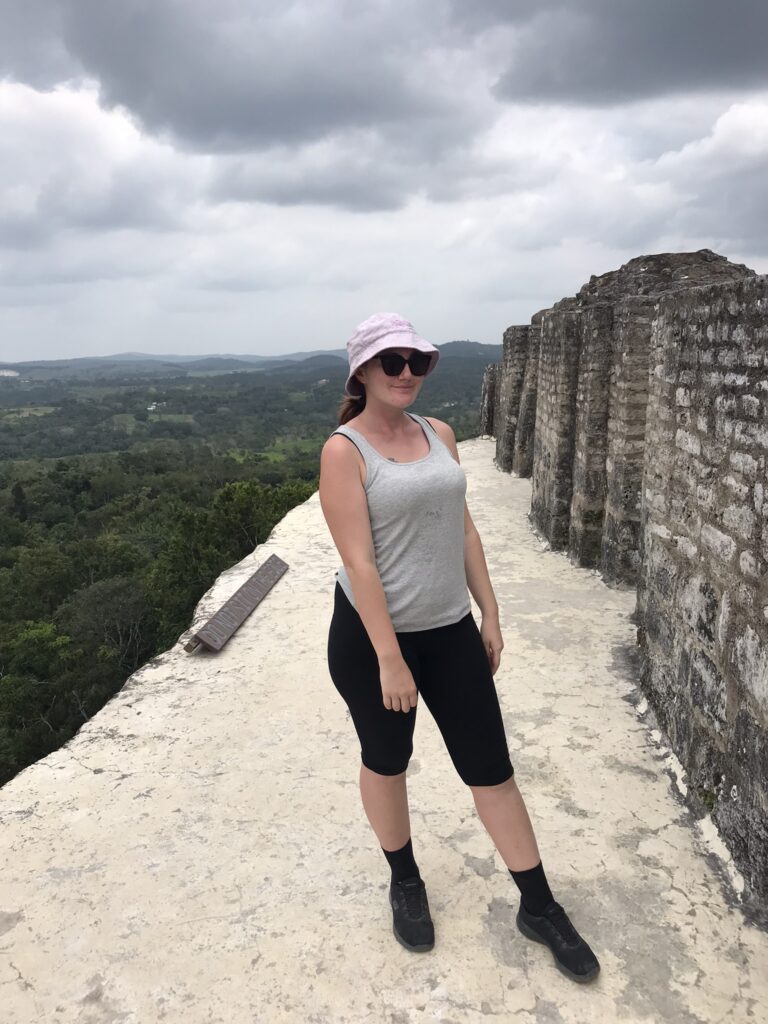
Atop the tallest temple at Xunantunich, ‘El Castillo’
The temple contains an impressive decorative frieze, which is probably the most unique feature of the site. There are a couple of other smaller temples and structures to explore too. Typically lots of iguanas can be found dotted around the site and atop the many structures, they are likely to start bobbing their heads in disapproval if you get too close.
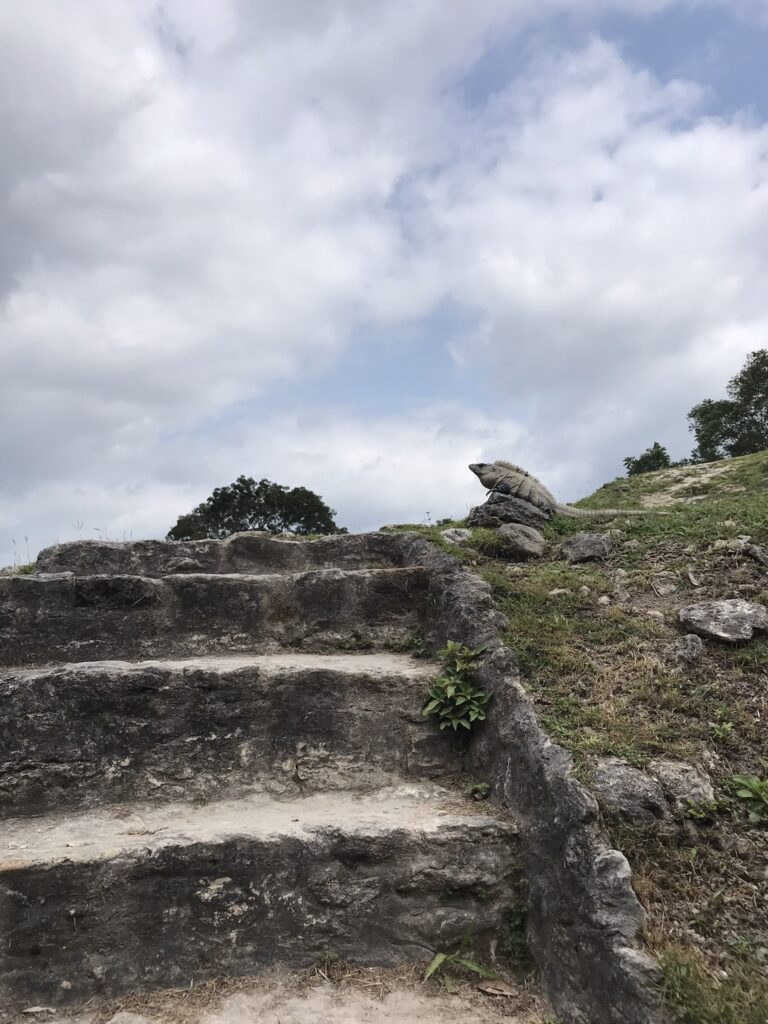
Iguanas keep watch at Xunantunich
Xunantunich is easy to access from San Ignacio – just take any chicken bus towards the border and tell the driver you’re heading to Xunantunich, you will be dropped off at the side of the road next to the river. From there you just need to cross the river on the hand crank ferry (which is free) and then walk up the hill to the archaeological site. The ferry has capacity for a couple of cars, although it looked a bit precarious for cars to us. The guys operating the ferry let Dan have a go cranking the ferry. It’s worth noting that we spotted a lot of wildlife on the walk up from the ferry to the archaeological site that might be missed if driving. After visiting the site you can get the bus back to San Ignacio or anywhere else, buses from the border pass by with regularity, just wait at the same place you were dropped off by the main road.
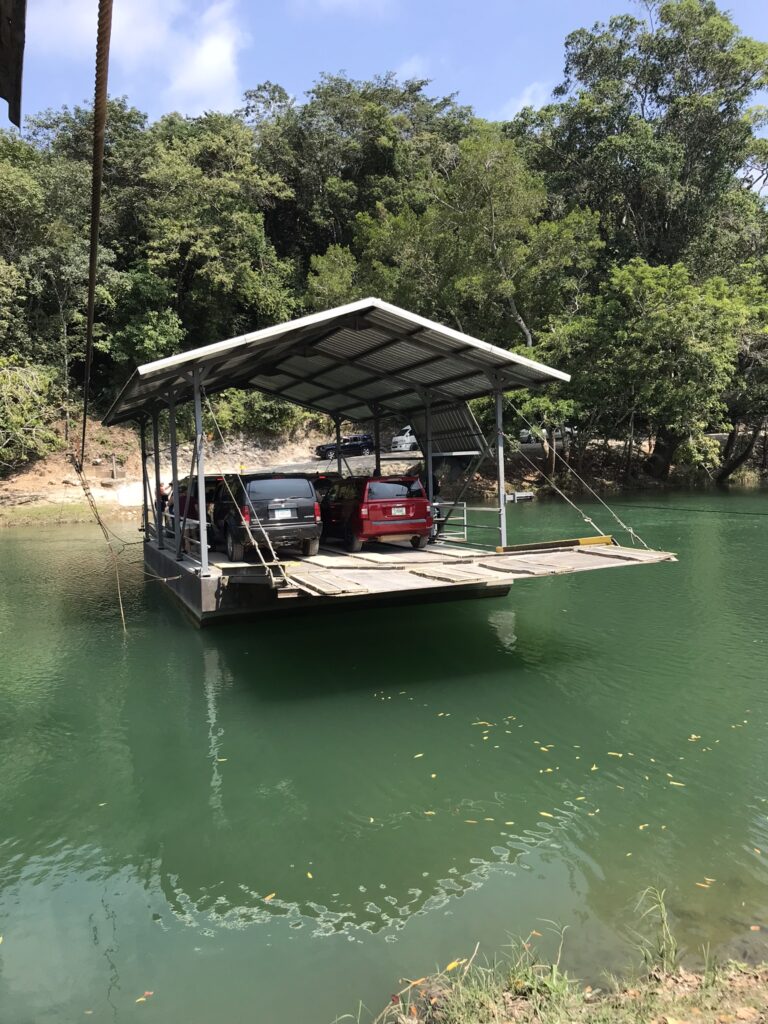
The hand-crank ferry is the only way to get across to Xunantunich
The archaeological site also includes a small museum/visitor centre housing some artefacts, which is a good place to cool down after walking up the hill as it has air conditioning. The only toilets are actually in the car park area before entering the site – go to the toilet before passing through admission to avoid walking up and down the hill multiple times.
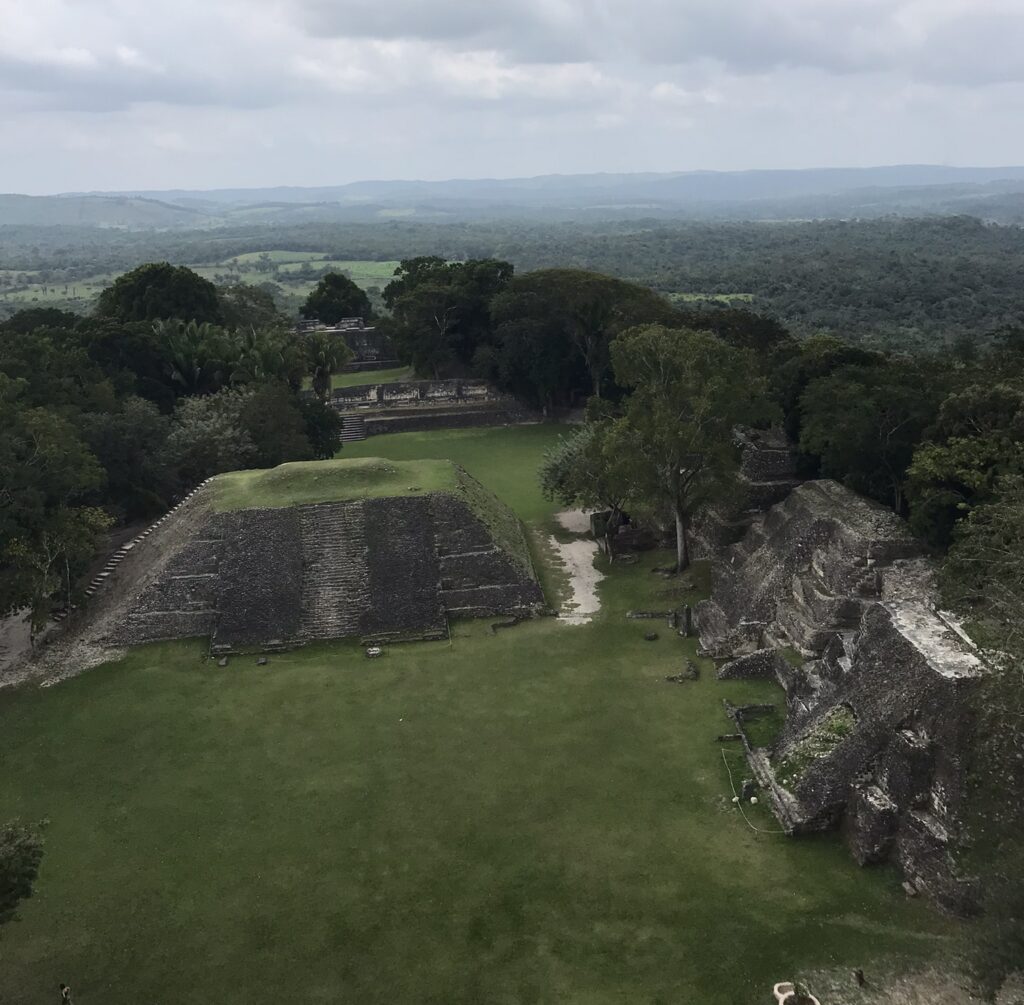
It’s not the most famous Mayan site but the ruins at Xunantunich are really impressive
Cahal Pech – a small and fairly quiet Mayan site within walking distance of the centre of San Ignacio, although it is an uphill walk from the centre so some people choose to take a taxi. The site includes a small museum area with some interesting displays and paintings, you pass through the museum and then walk out to the ruins.
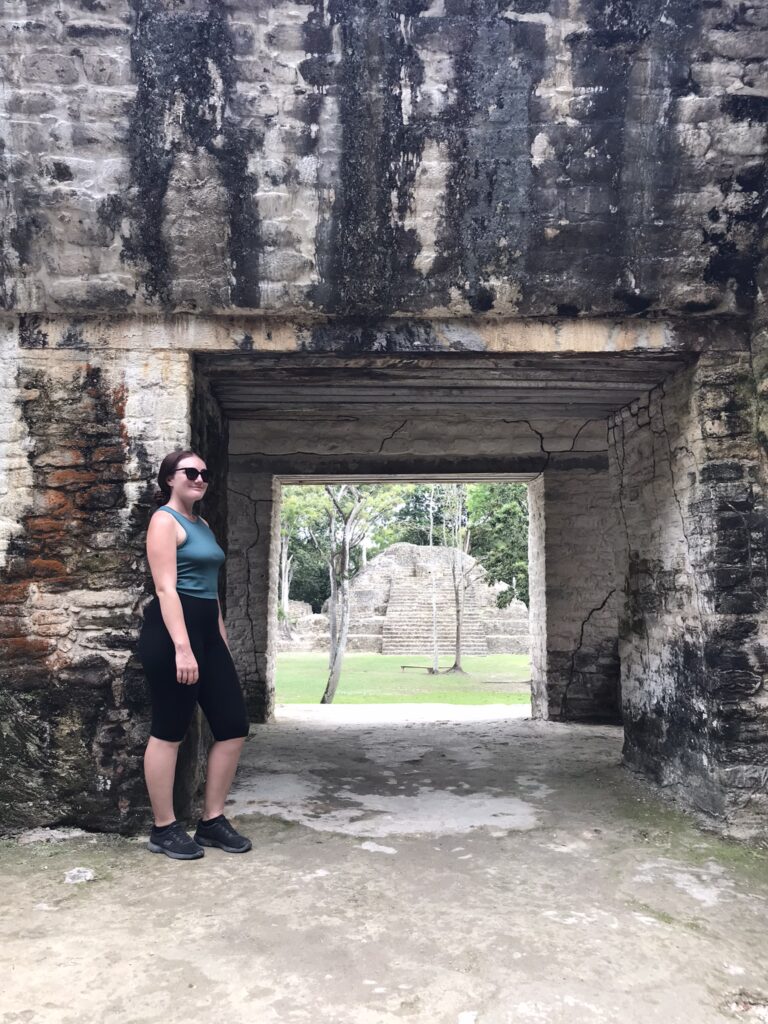
There are a few nooks and crannies to explore at Cahal Pech
In terms of Mayan ruins, Cahal Pech is pretty generic with the typical courtyard, temples and small ball court etc. There are a couple of areas to explore but it is really most notable just because of how close it is to the modern town of San Ignacio.
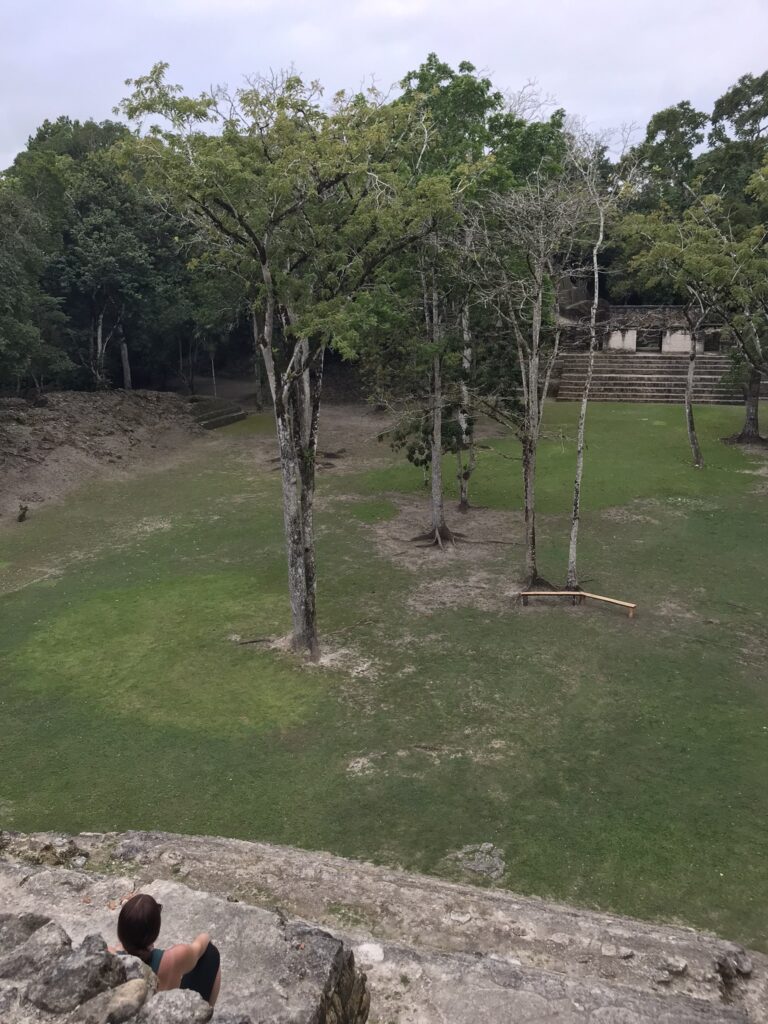
Soaking up the views at Cahal Pech
Green Iguana Conservation Project – a legitimate conservation project which is, strangely, located in the grounds of the San Ignacio Resort (a 4* hotel). You have to book at the reception of the hotel and can then wait inside the hotel lobby for the short tour. Tours take place every hour. This conservation project and breeding program focuses on green iguanas, which were traditionally hunted by local people in the region for food and other purposes causing their population to diminish. The project now works with the community to teach people to look after the iguanas, as well as breeding and releasing young iguanas back into the wild to replenish their population.
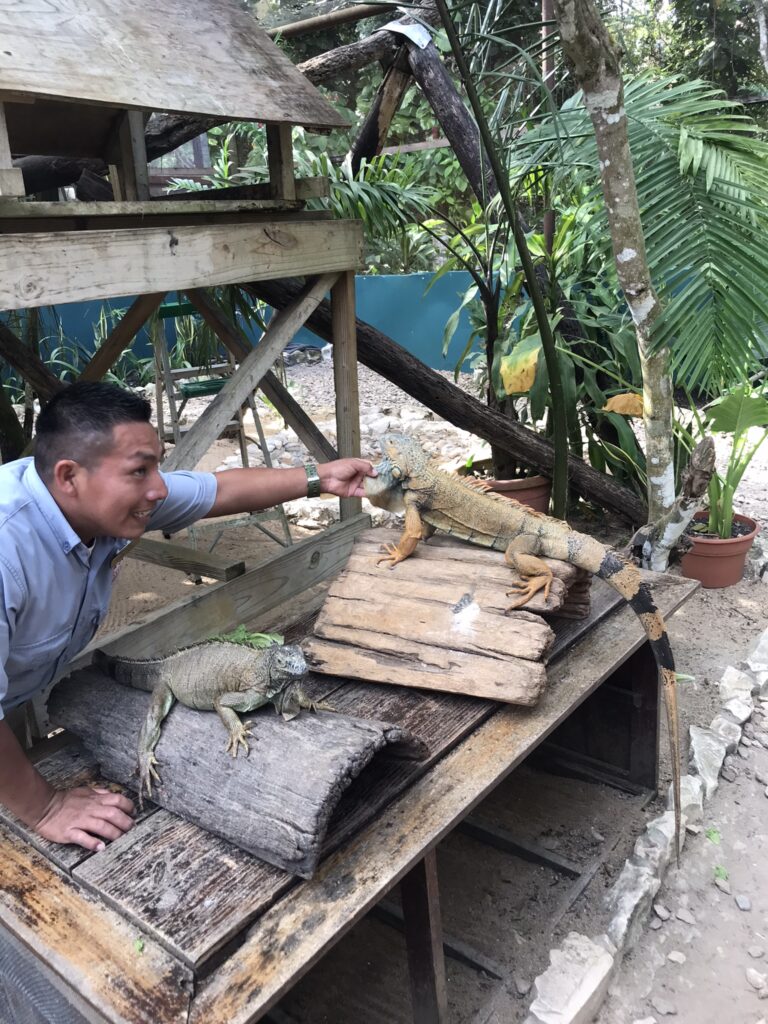
This guy was very enthusiastic about iguanas
The project’s visitor area is located in a small enclosure at the back of the hotel, you have to walk past the hotel swimming pool to get there! They are very careful about hygiene to protect the iguanas, visitors have to wash their hands before and after interacting with the iguanas.
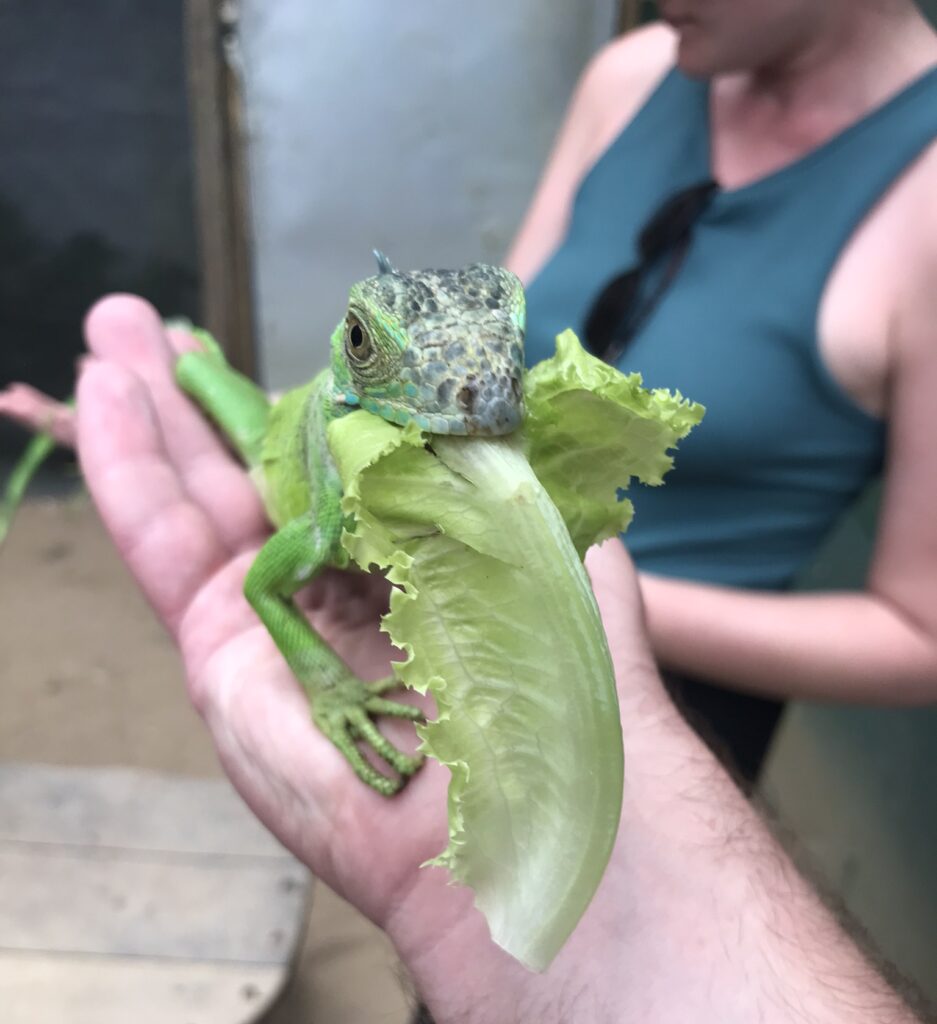
The tour is short and there isn’t a lot to see, the guide is a conservation worker who talks about the aims and work of the project and then gives some information about the body language and behaviours of the iguanas as well as the difference between green and grey iguanas. Visitors then get to feed leaves to the iguanas and are shown how to safely handle some of them, with ample photo opportunities.
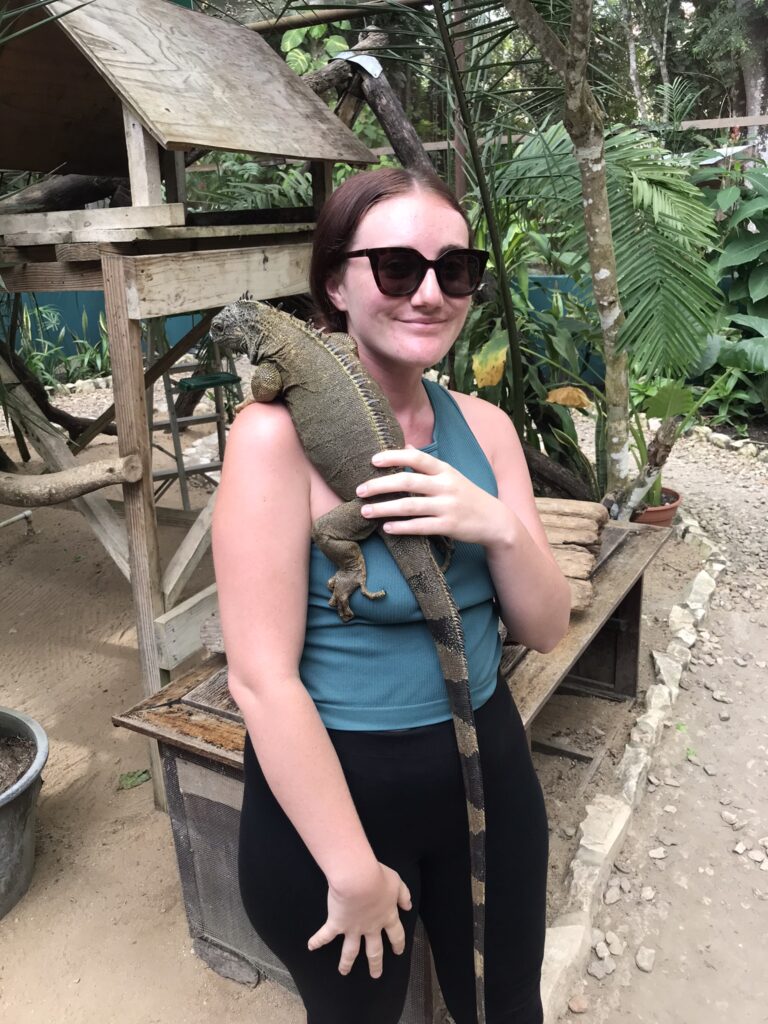
I couldn’t resist
After visiting Belize, we headed to Guatemala. Check out my experience crossing the border at Melchor de Mencos here!
